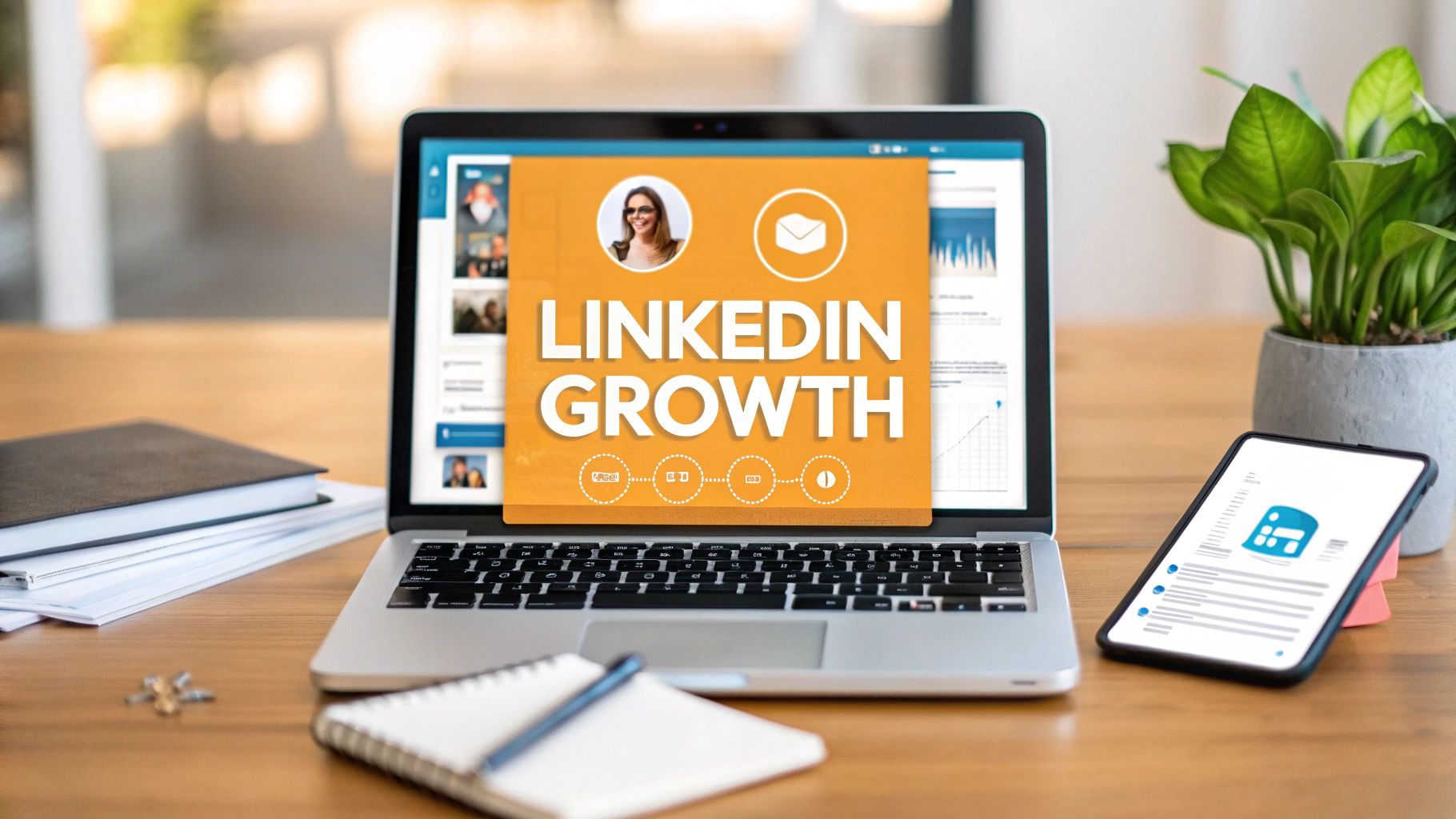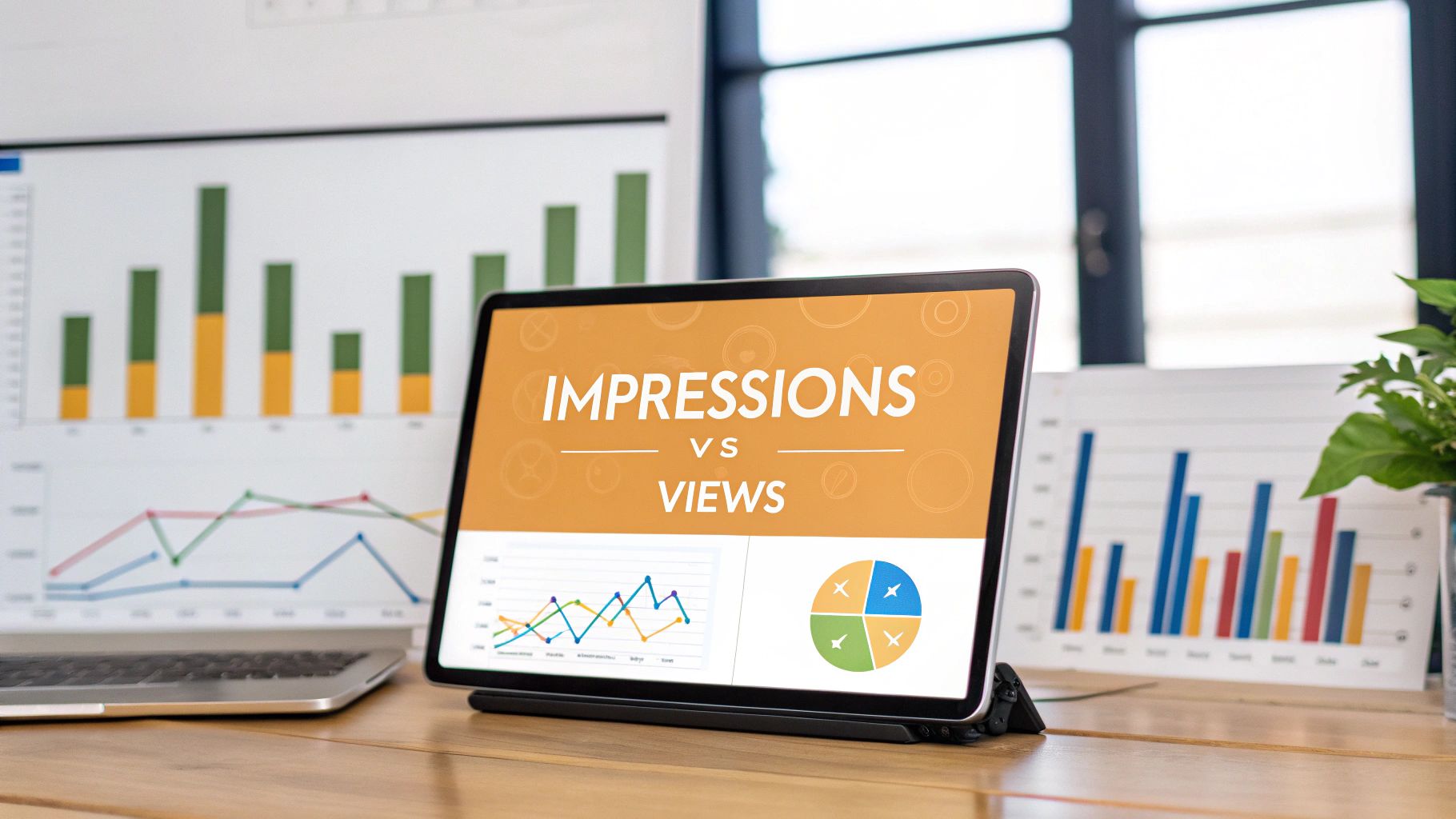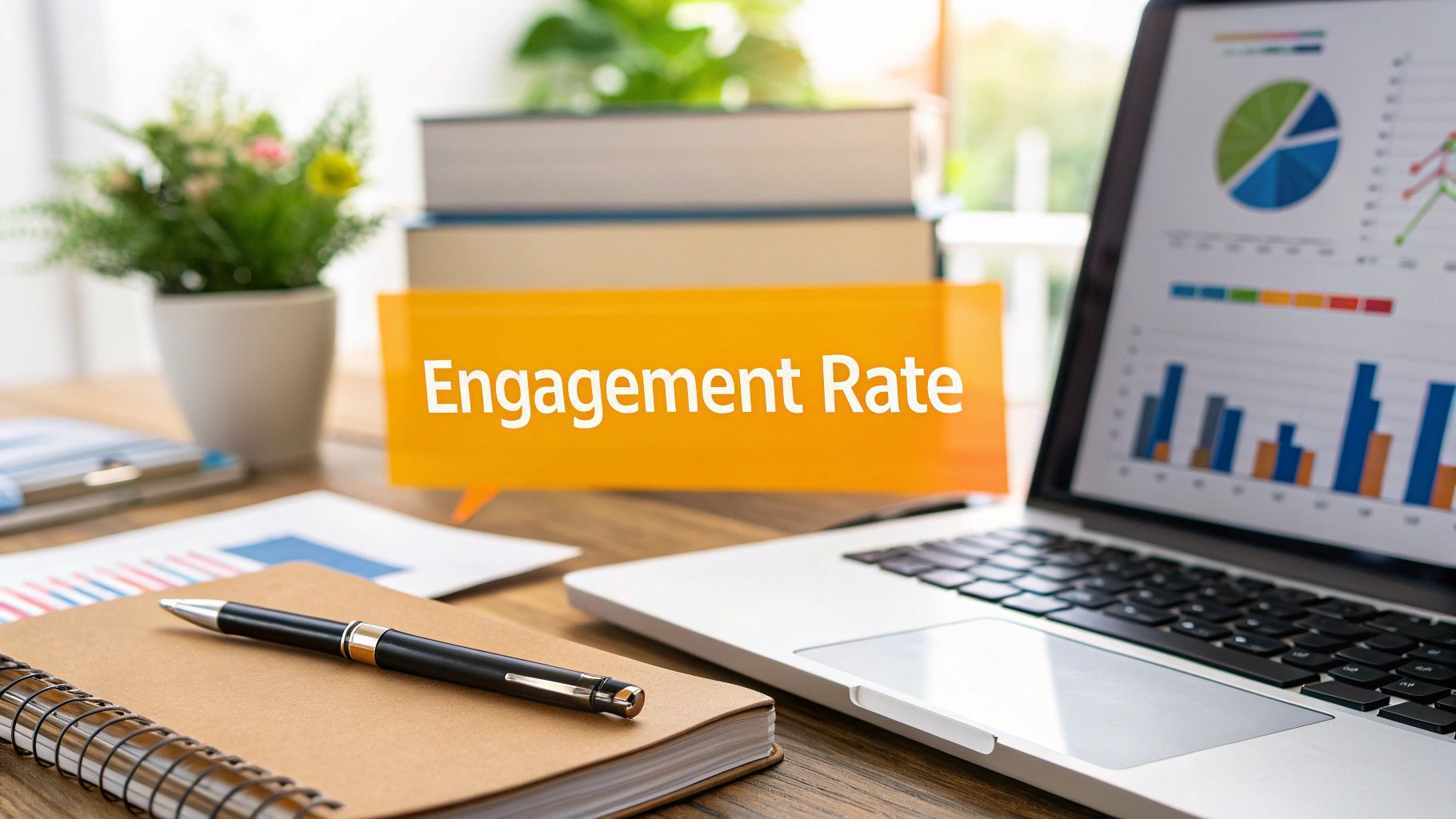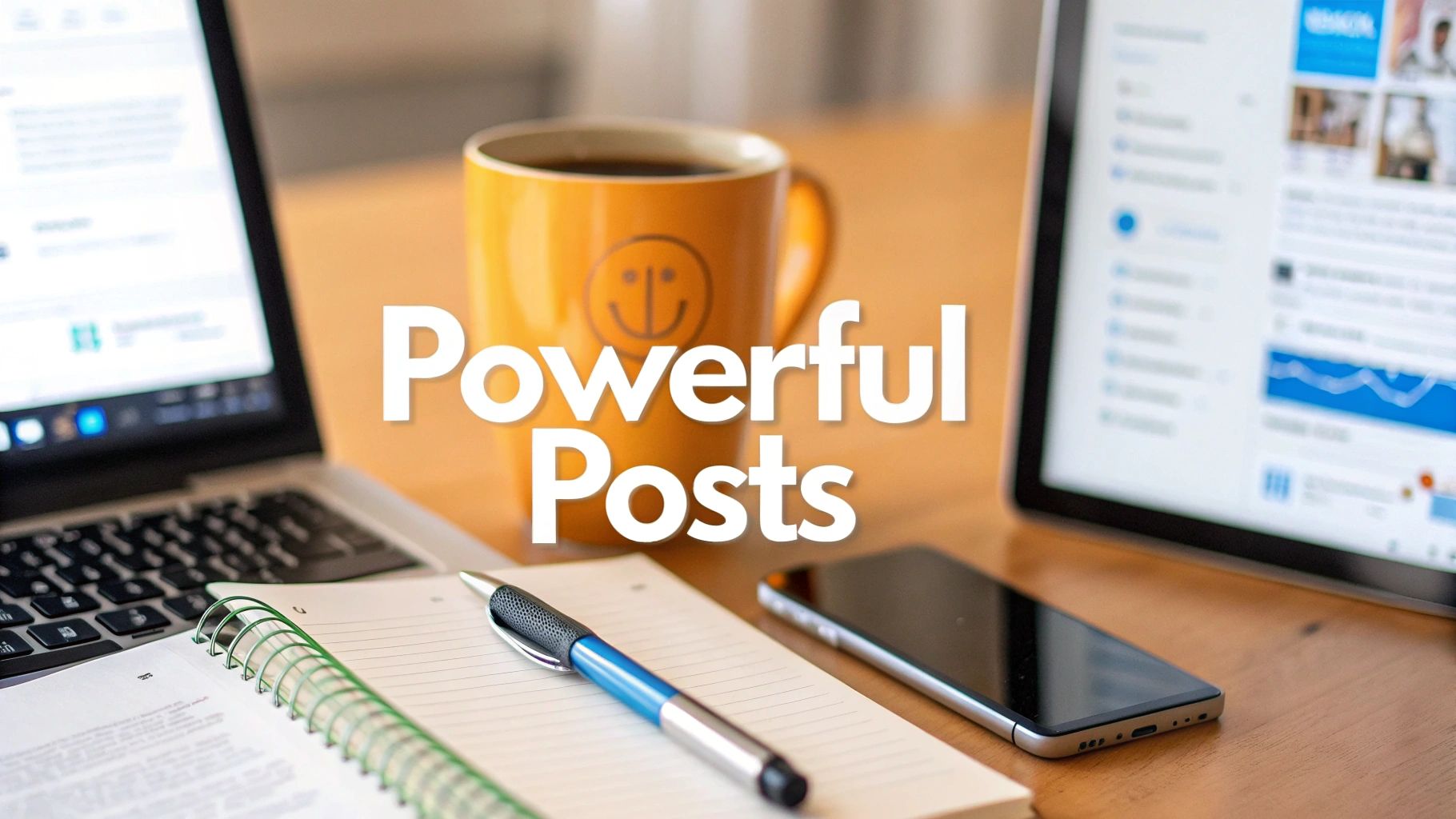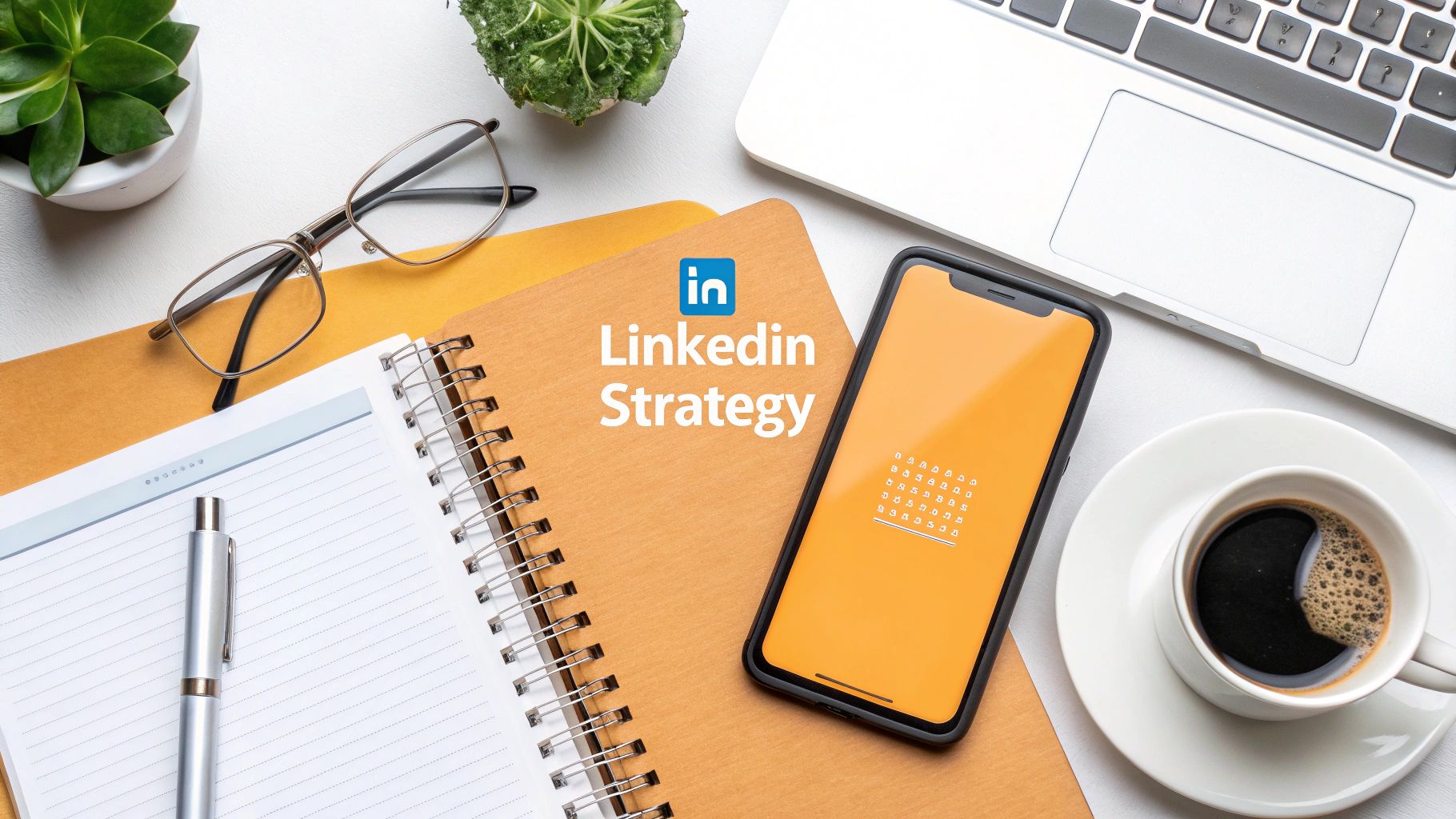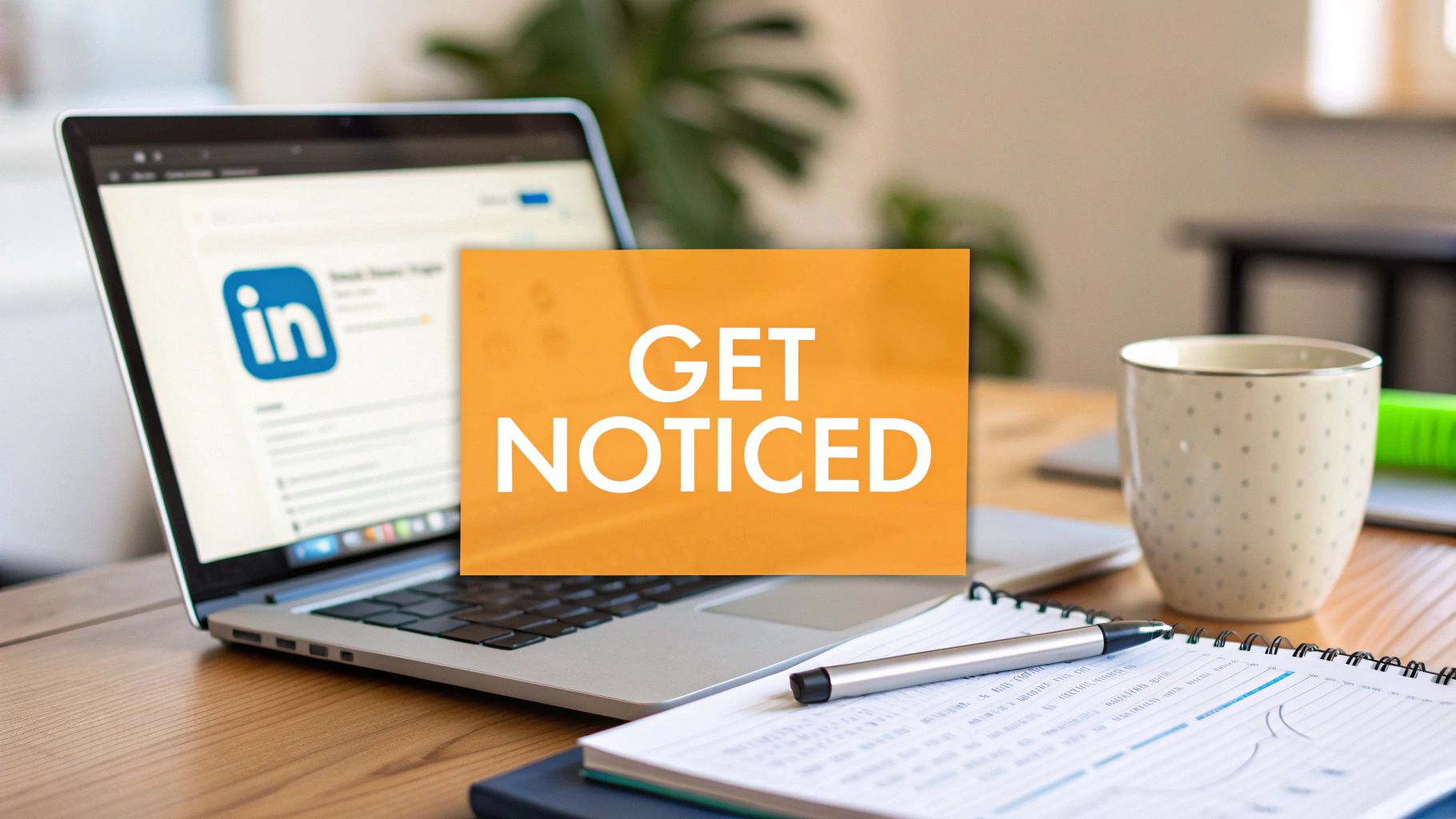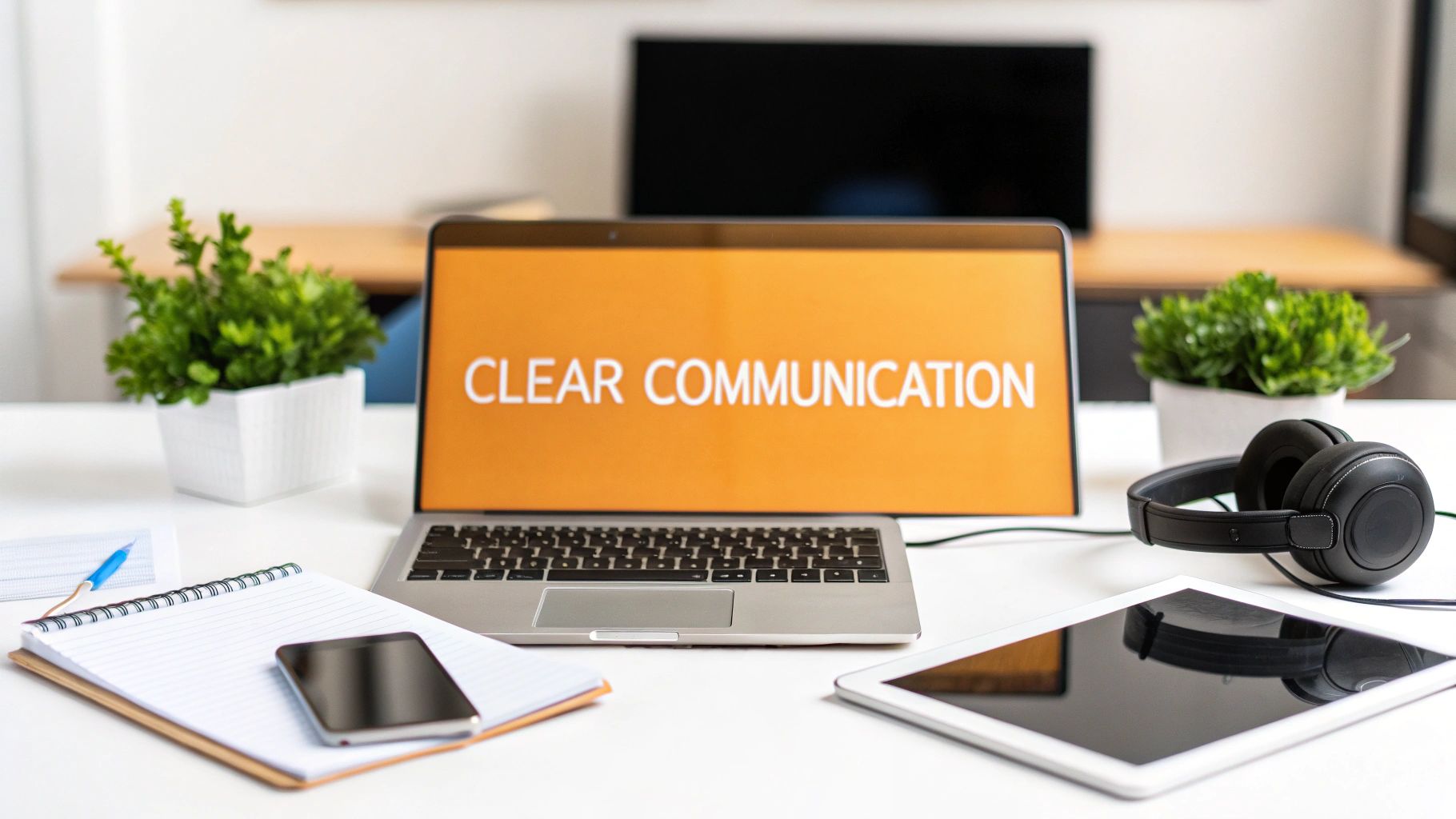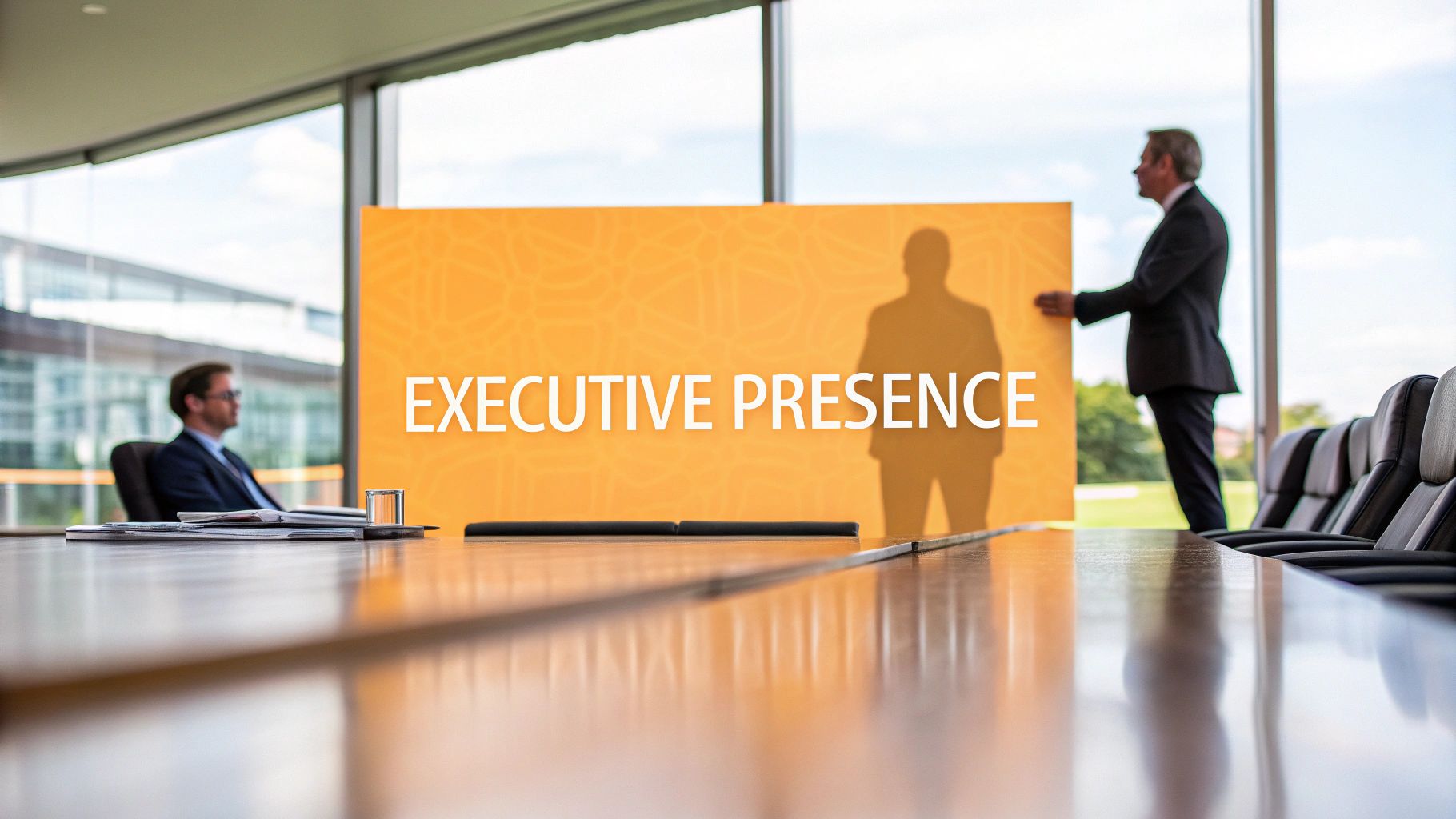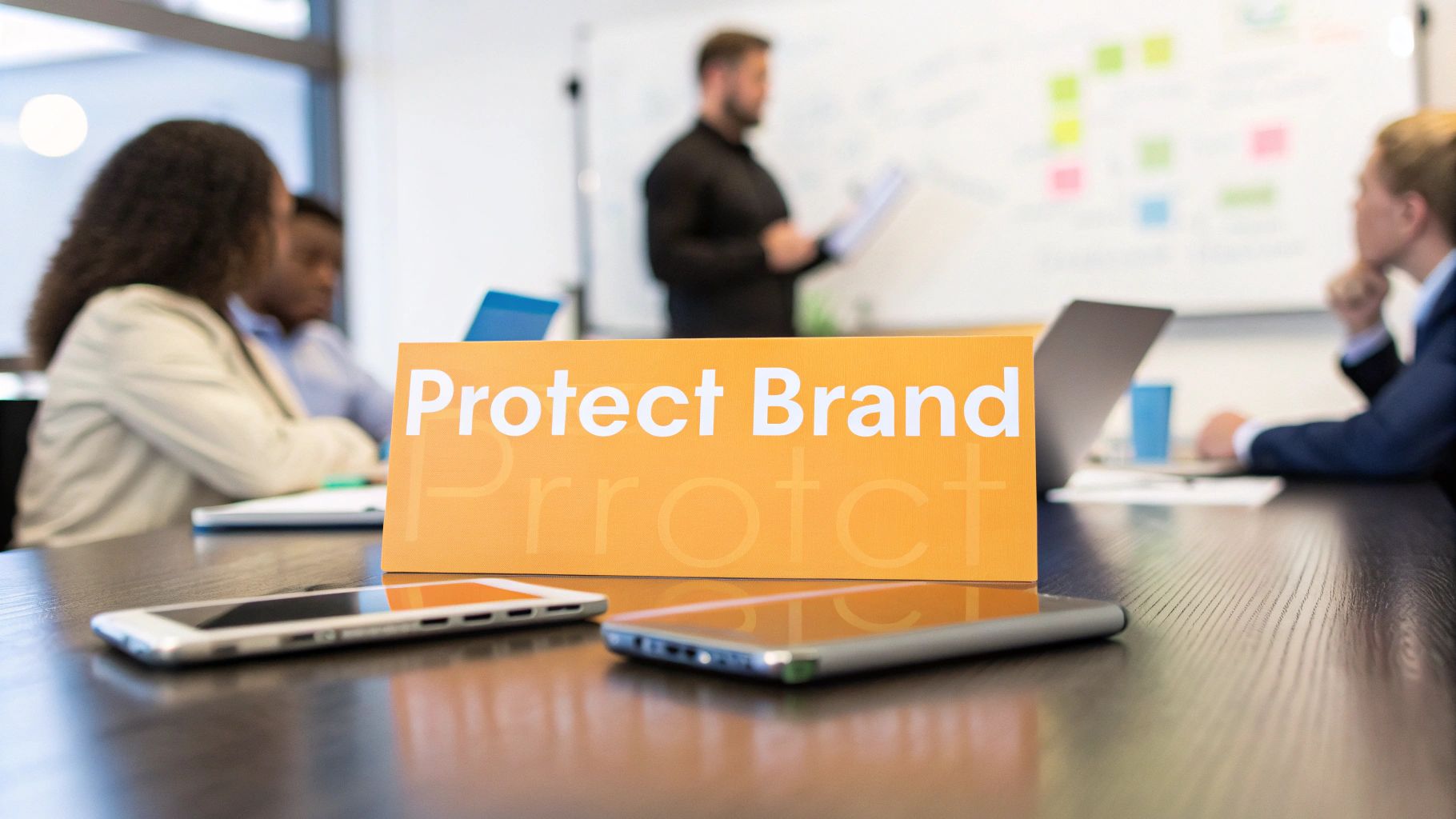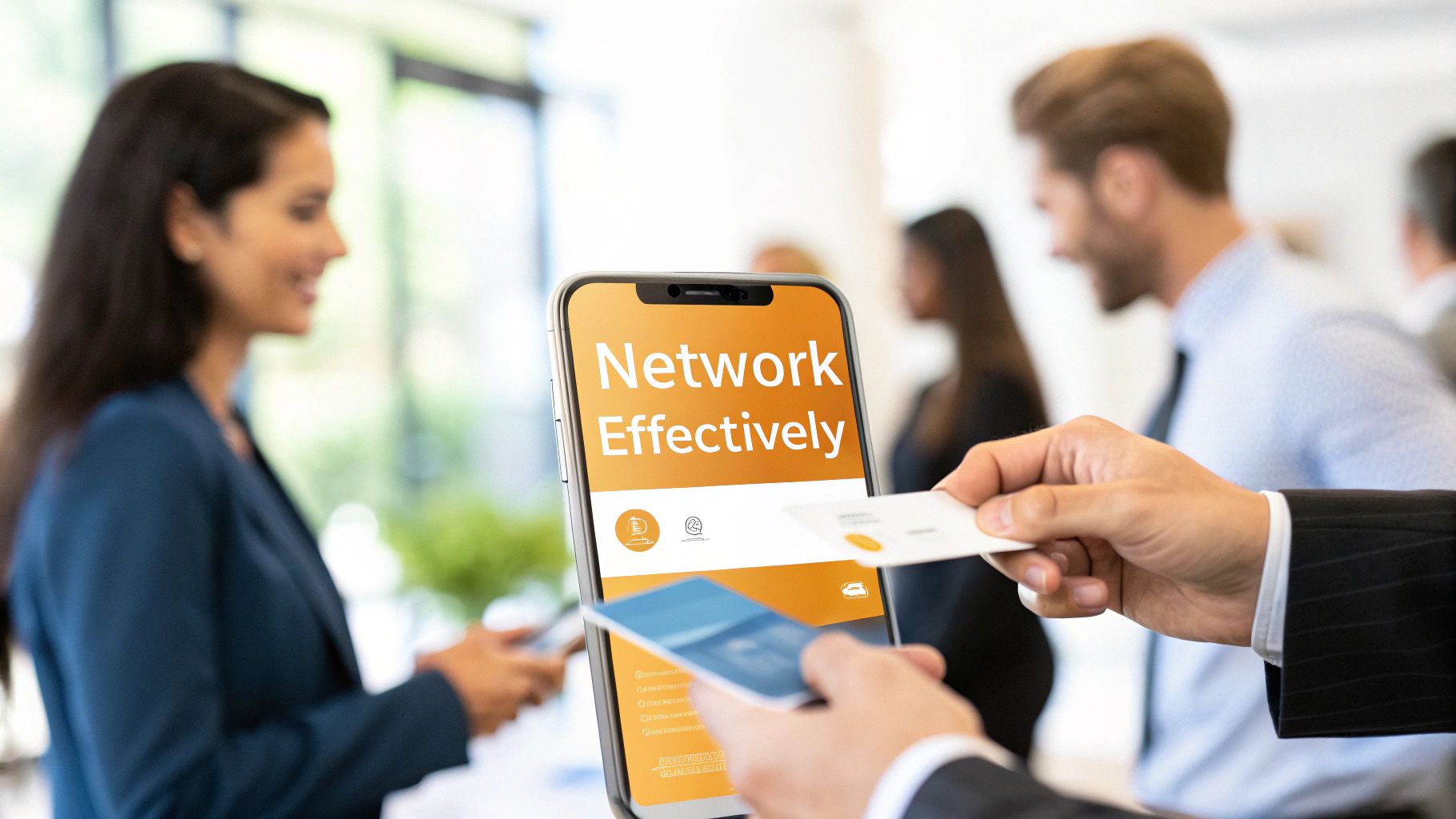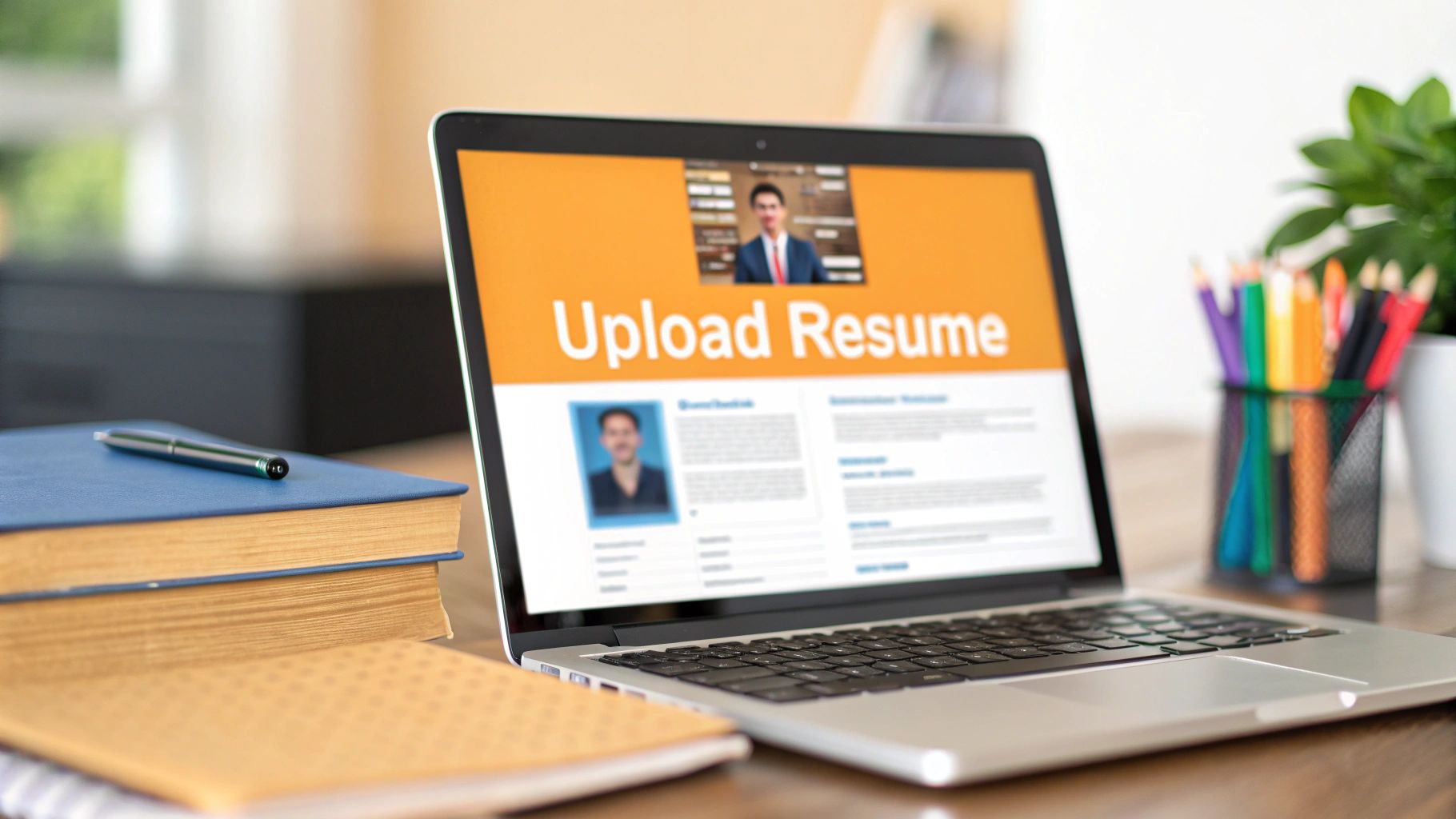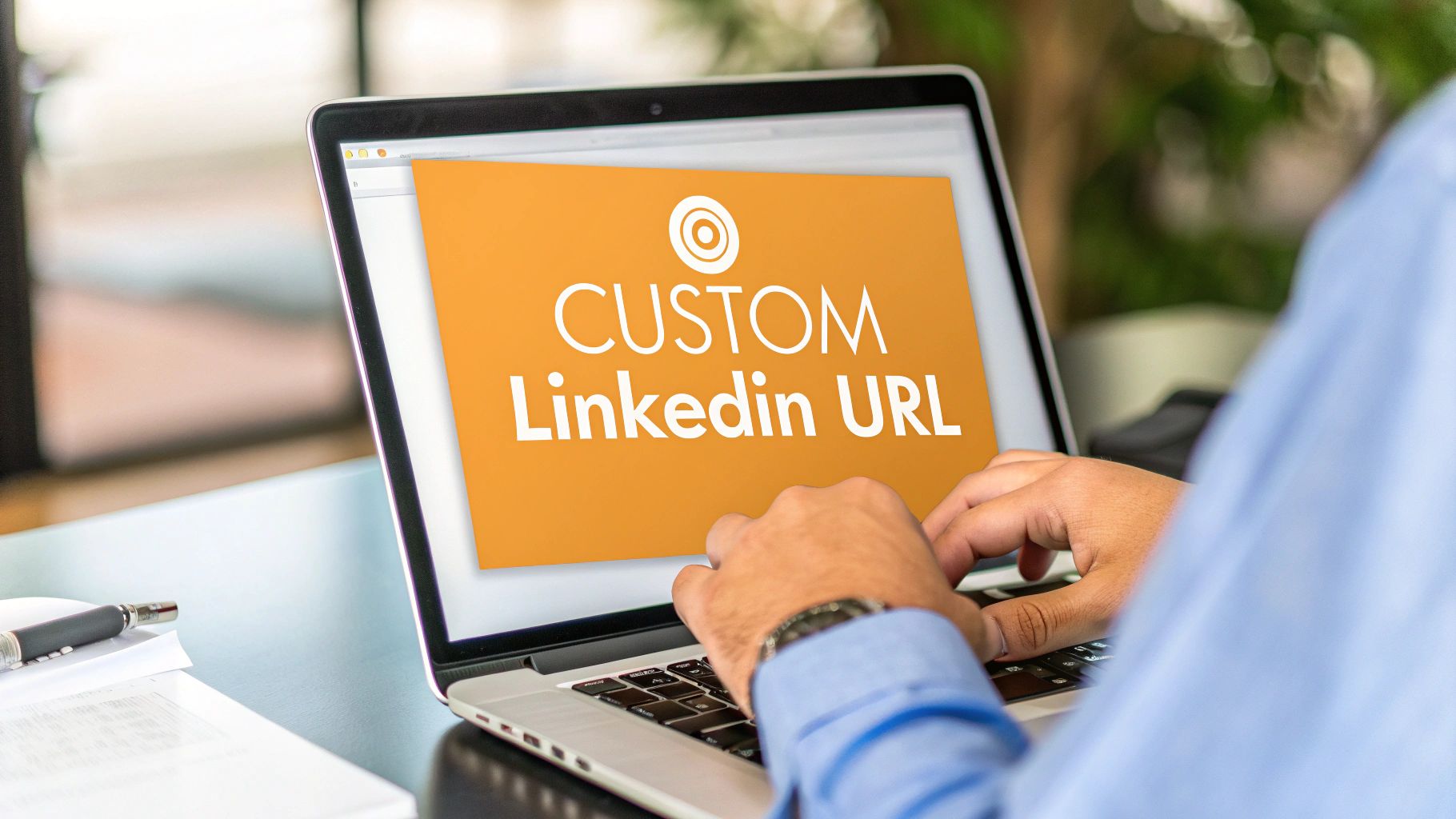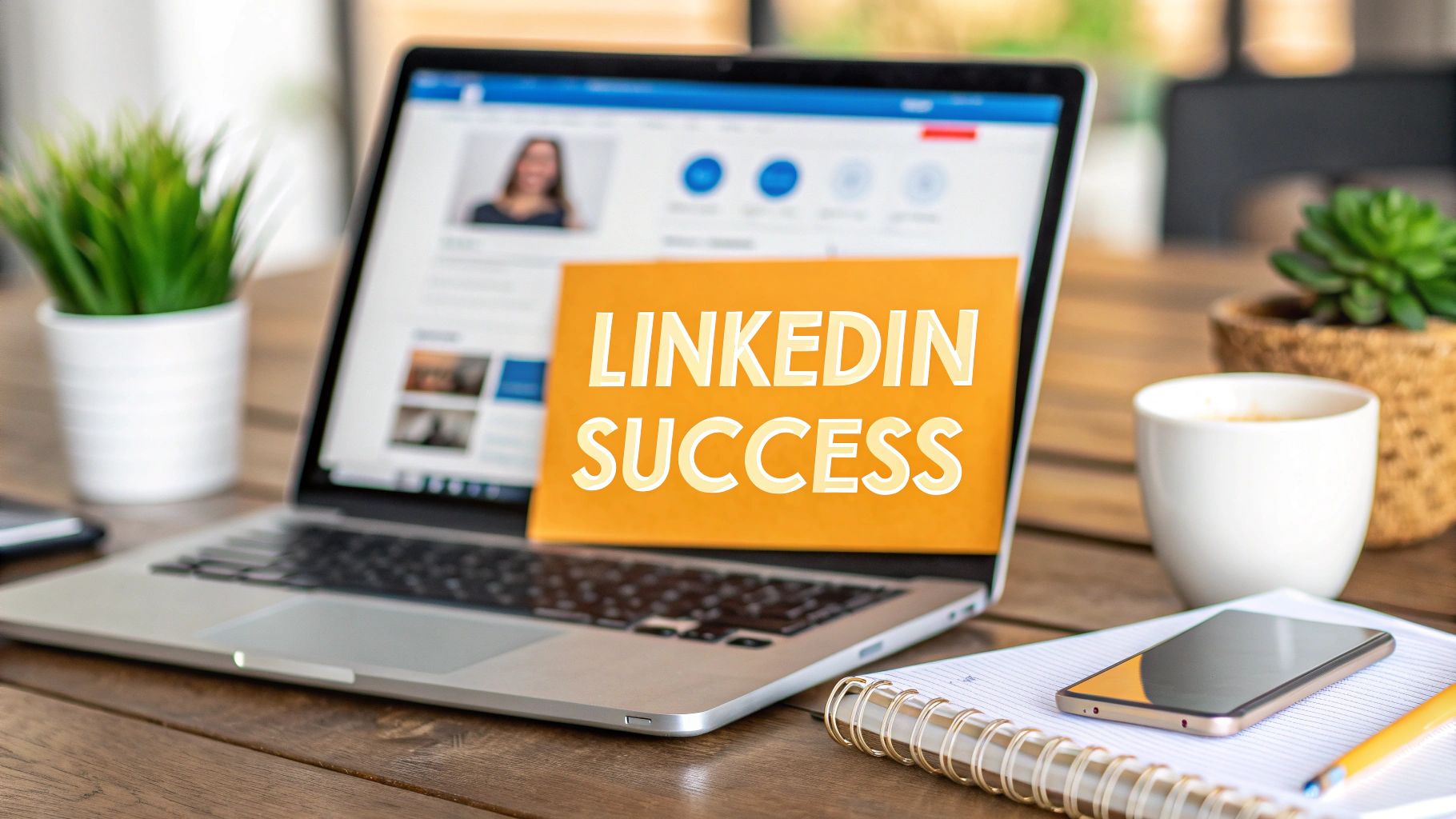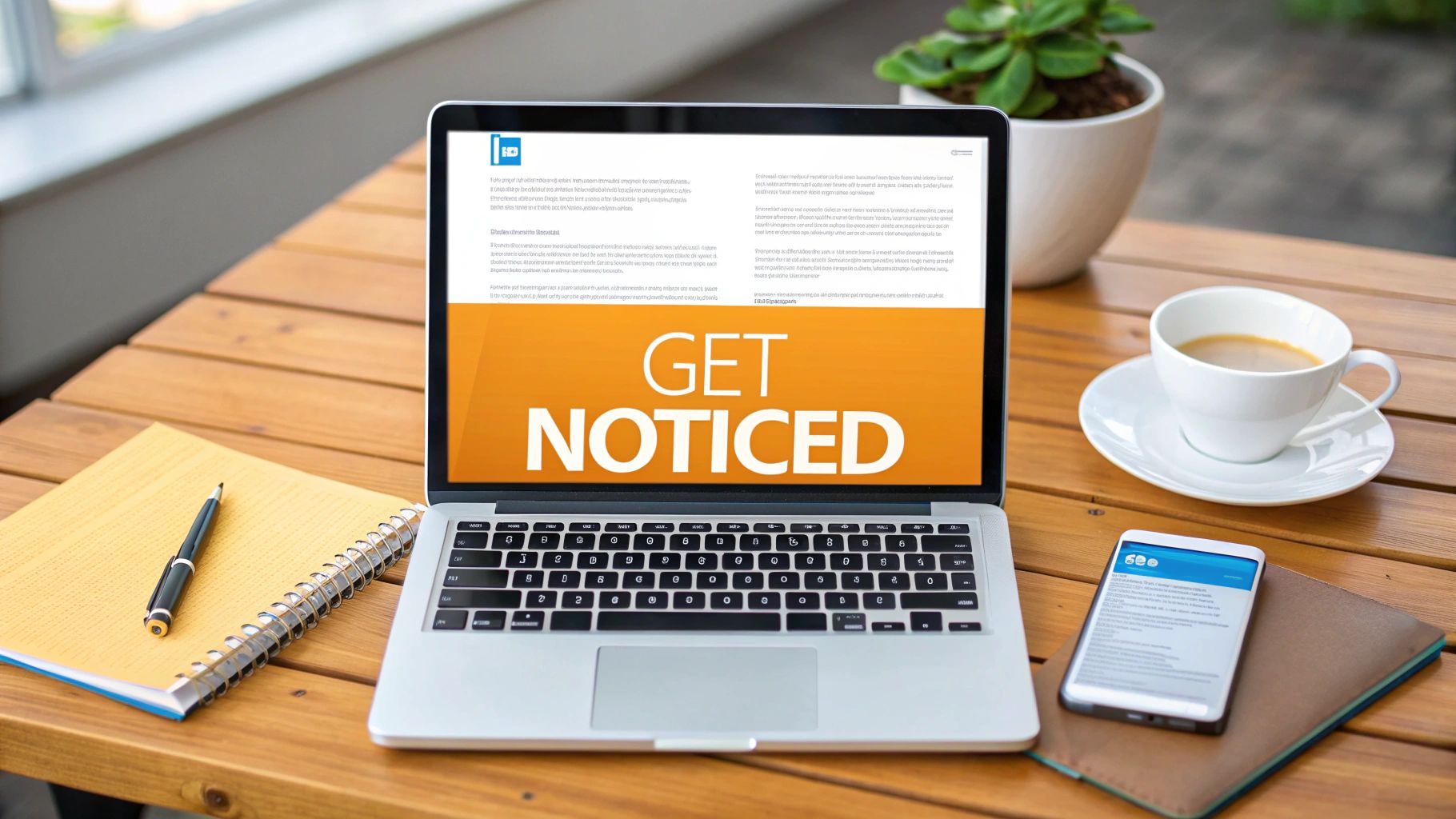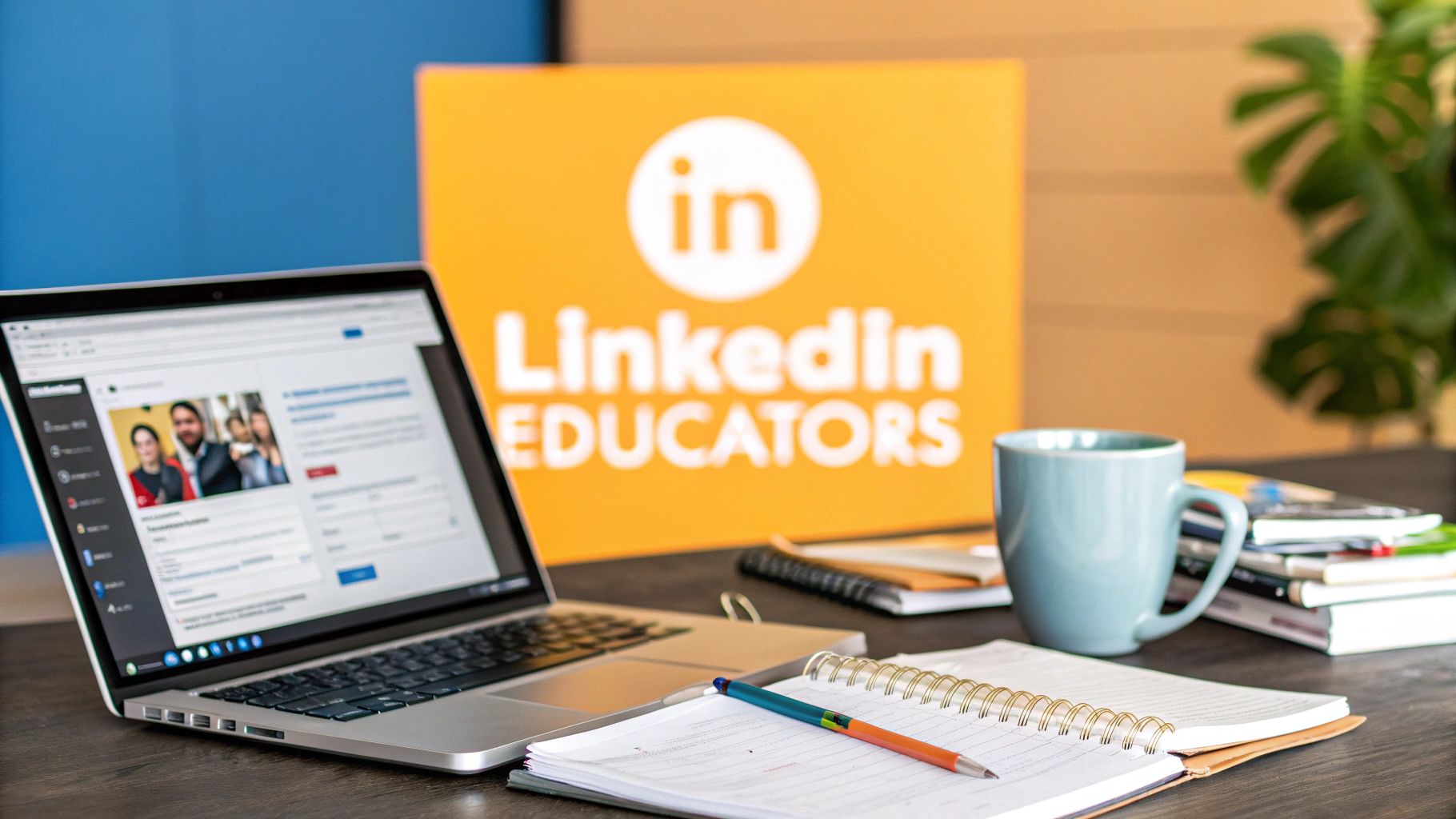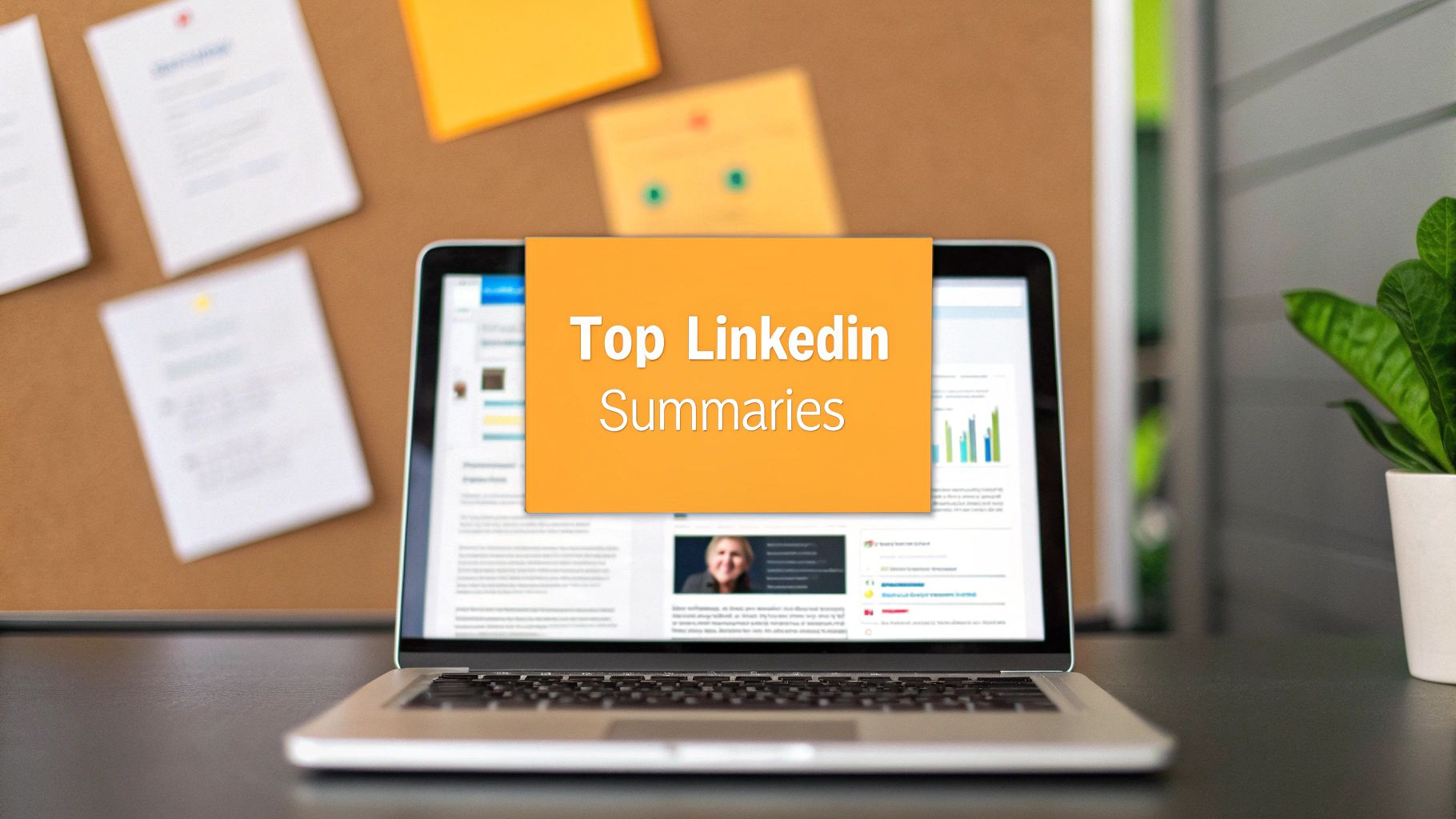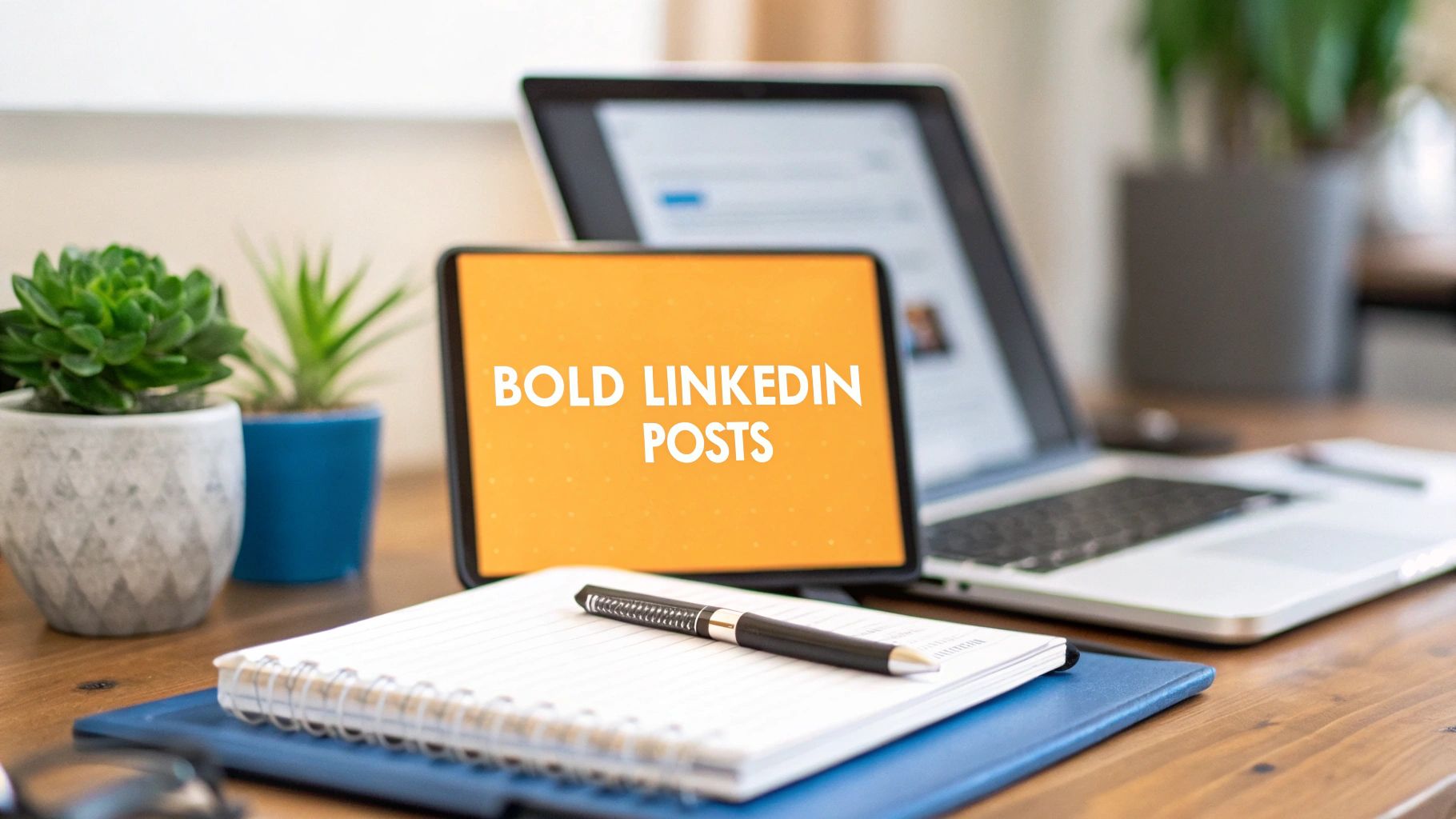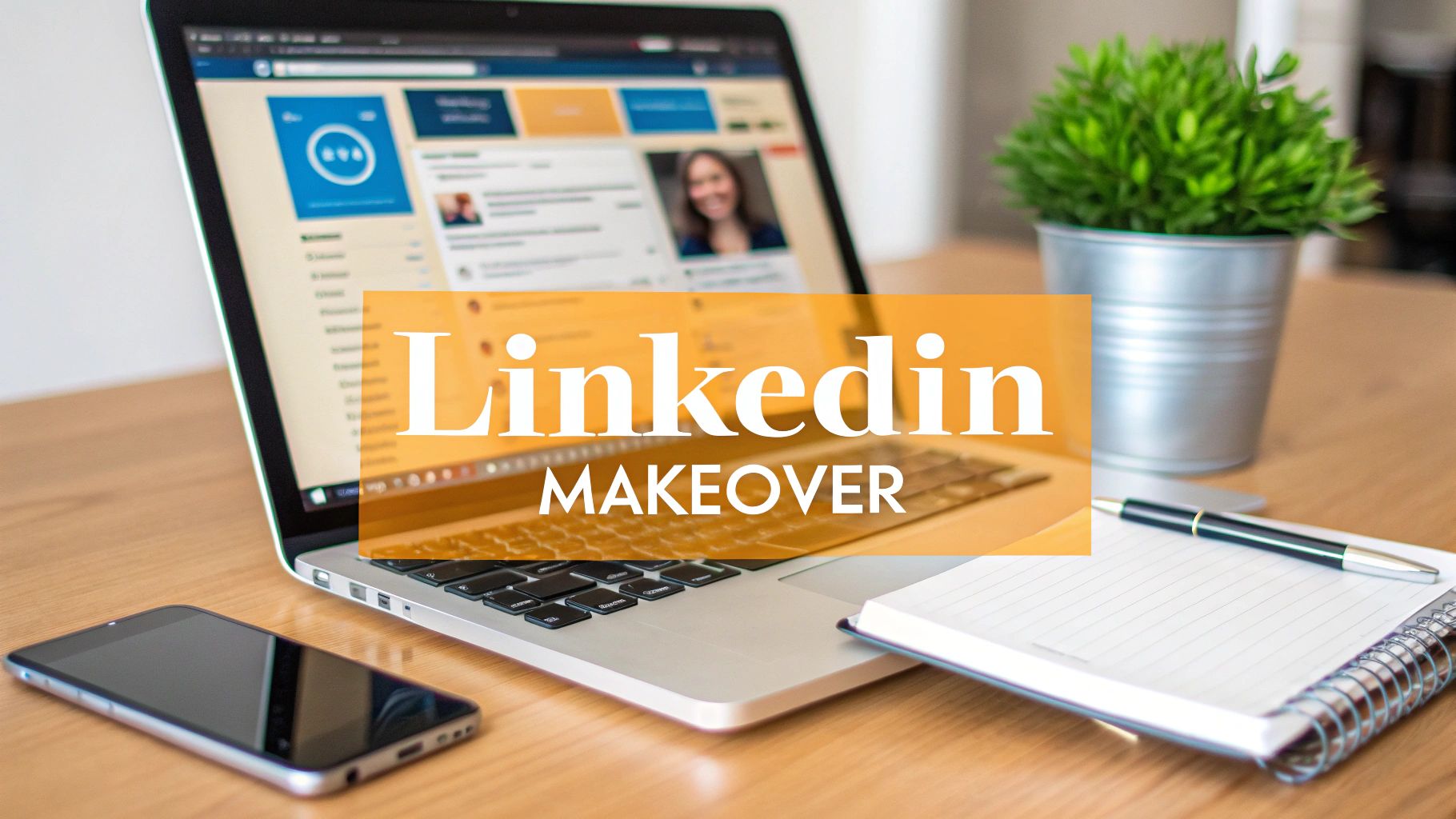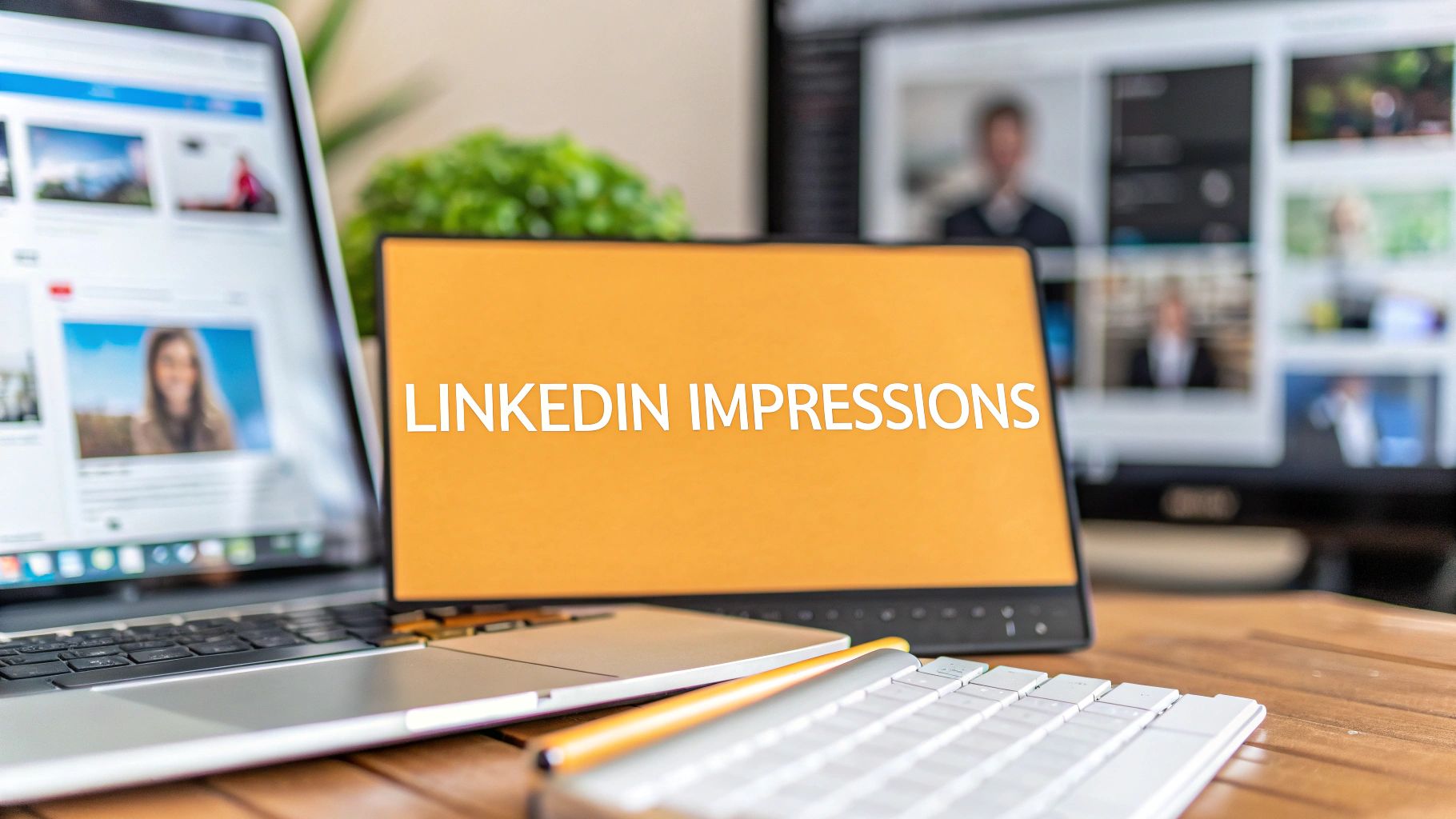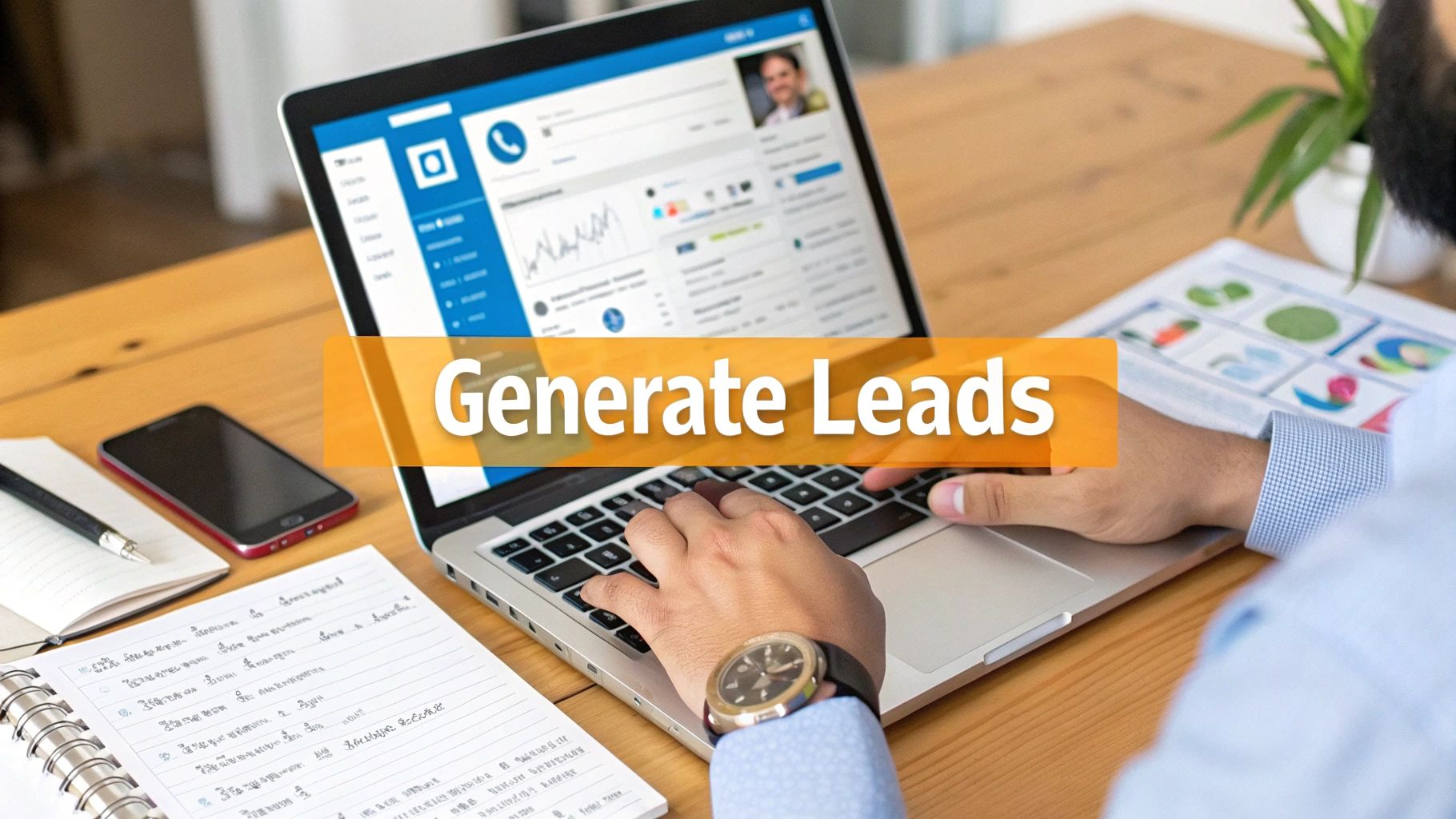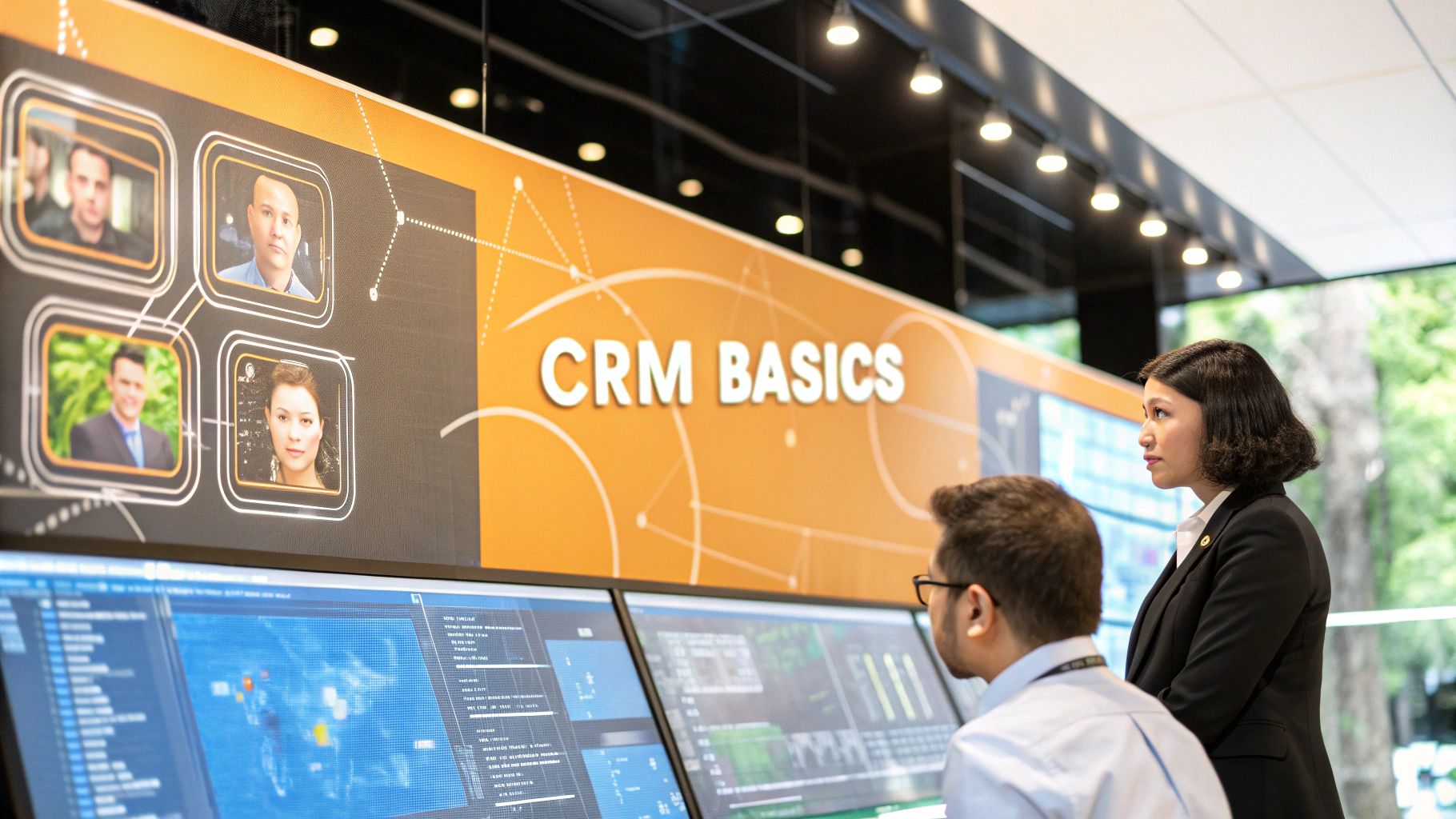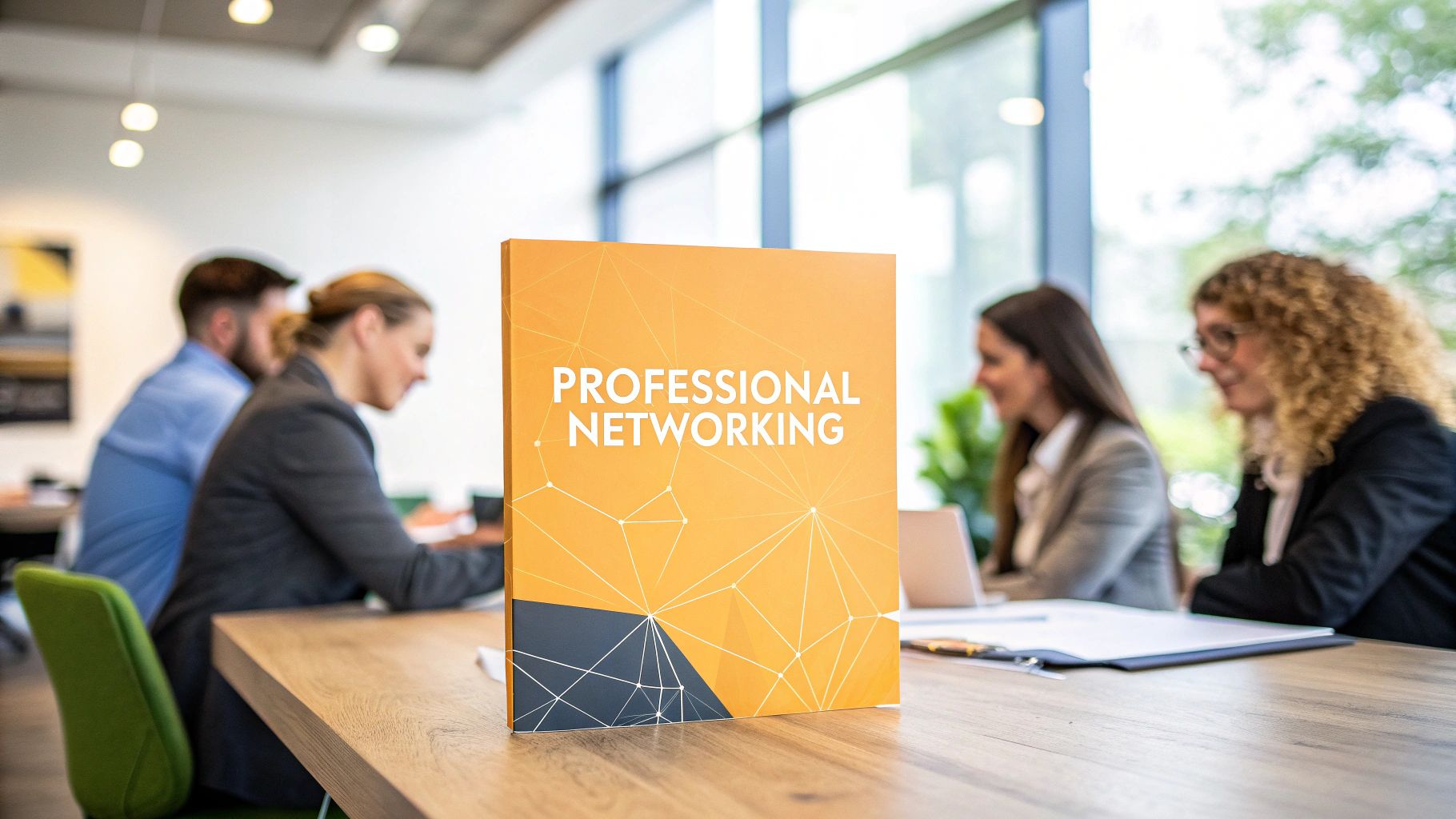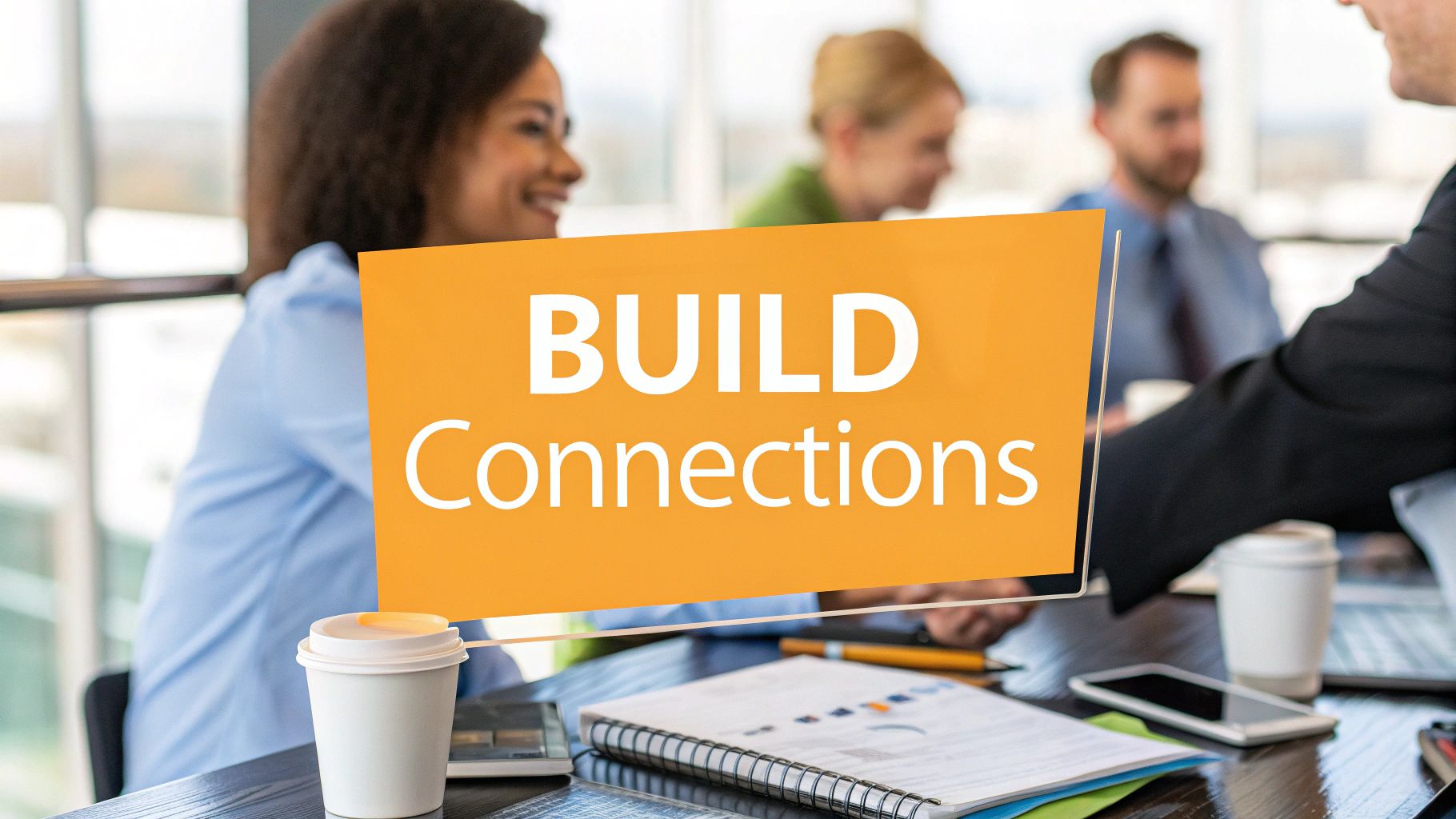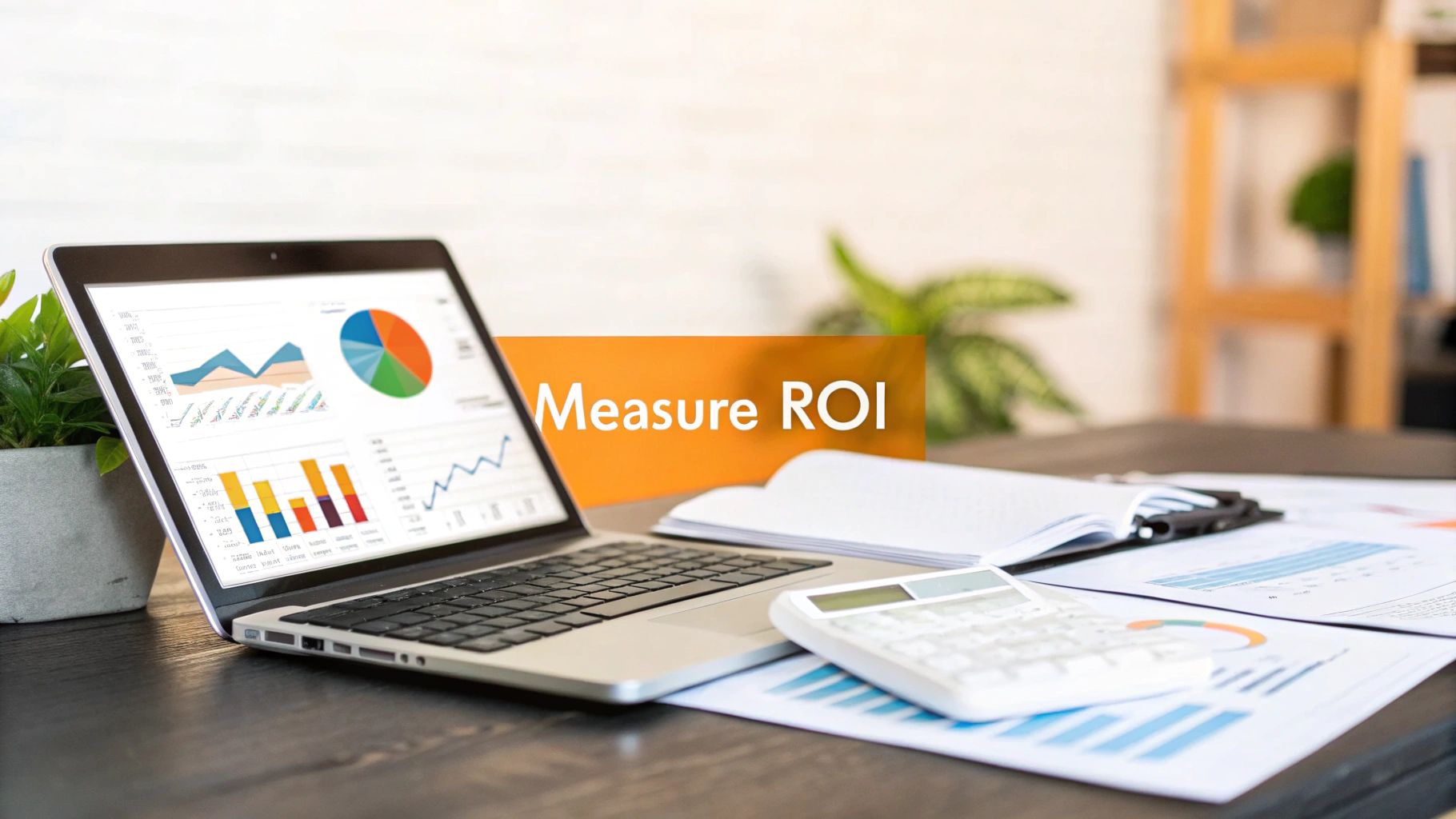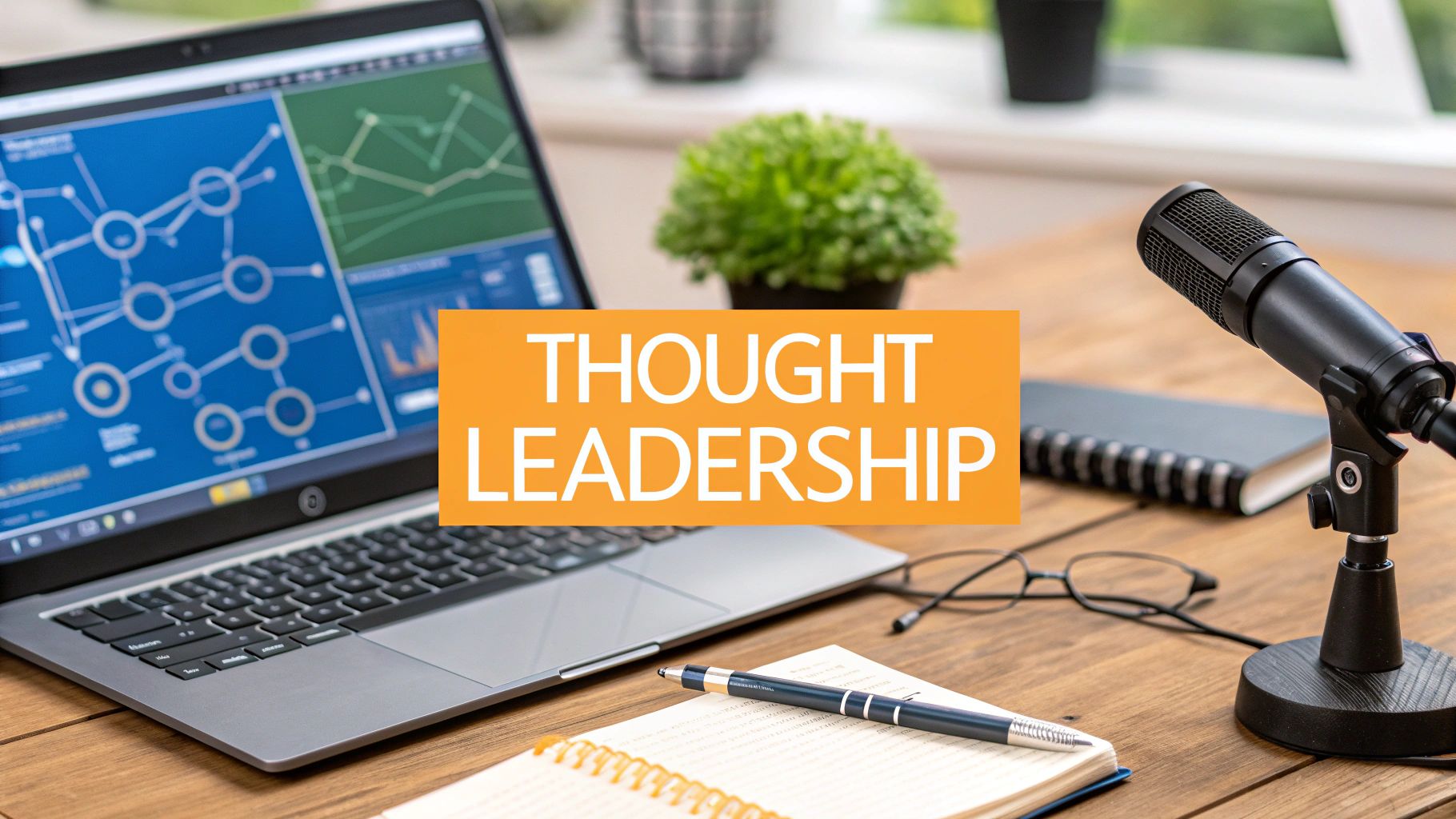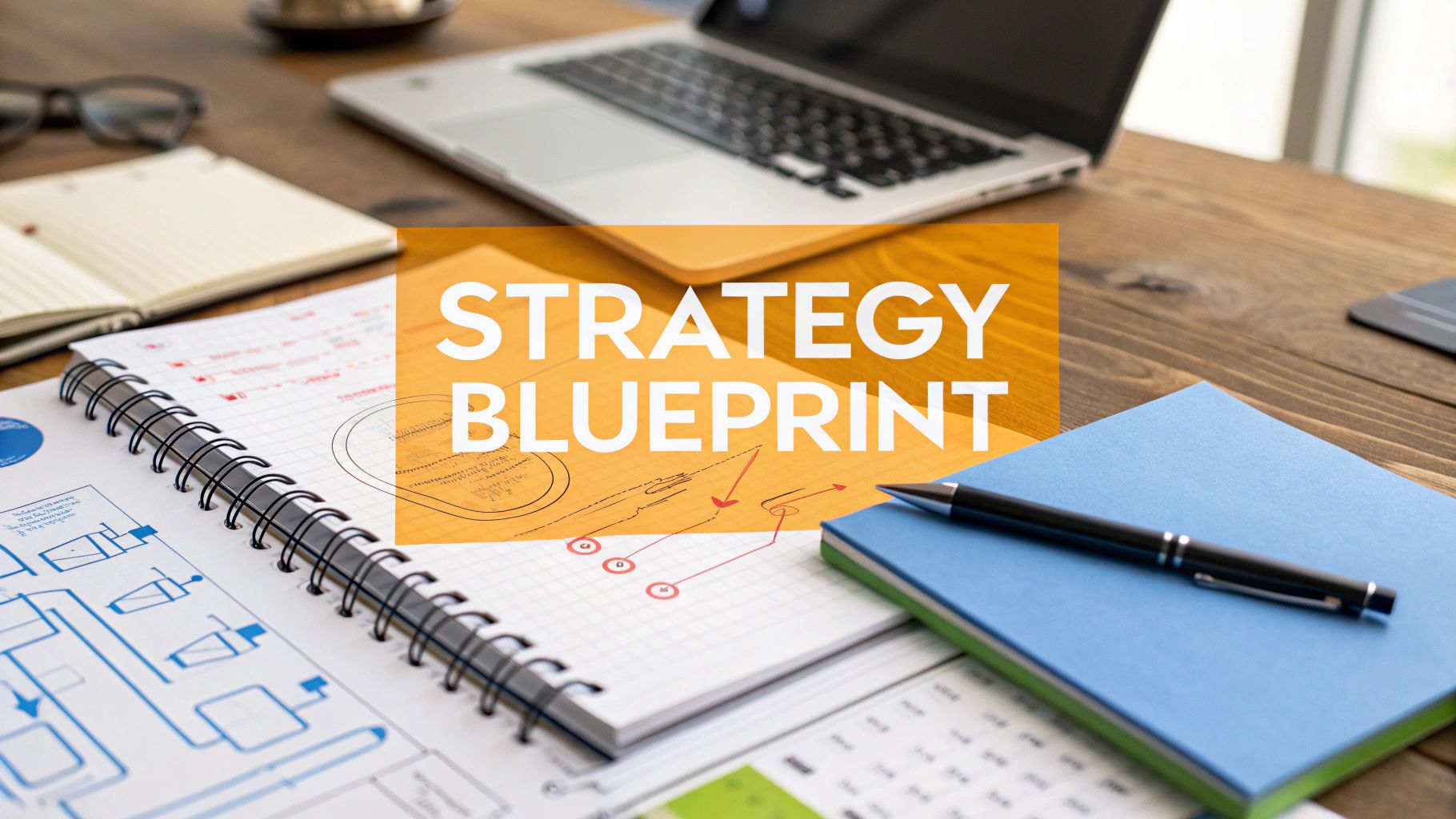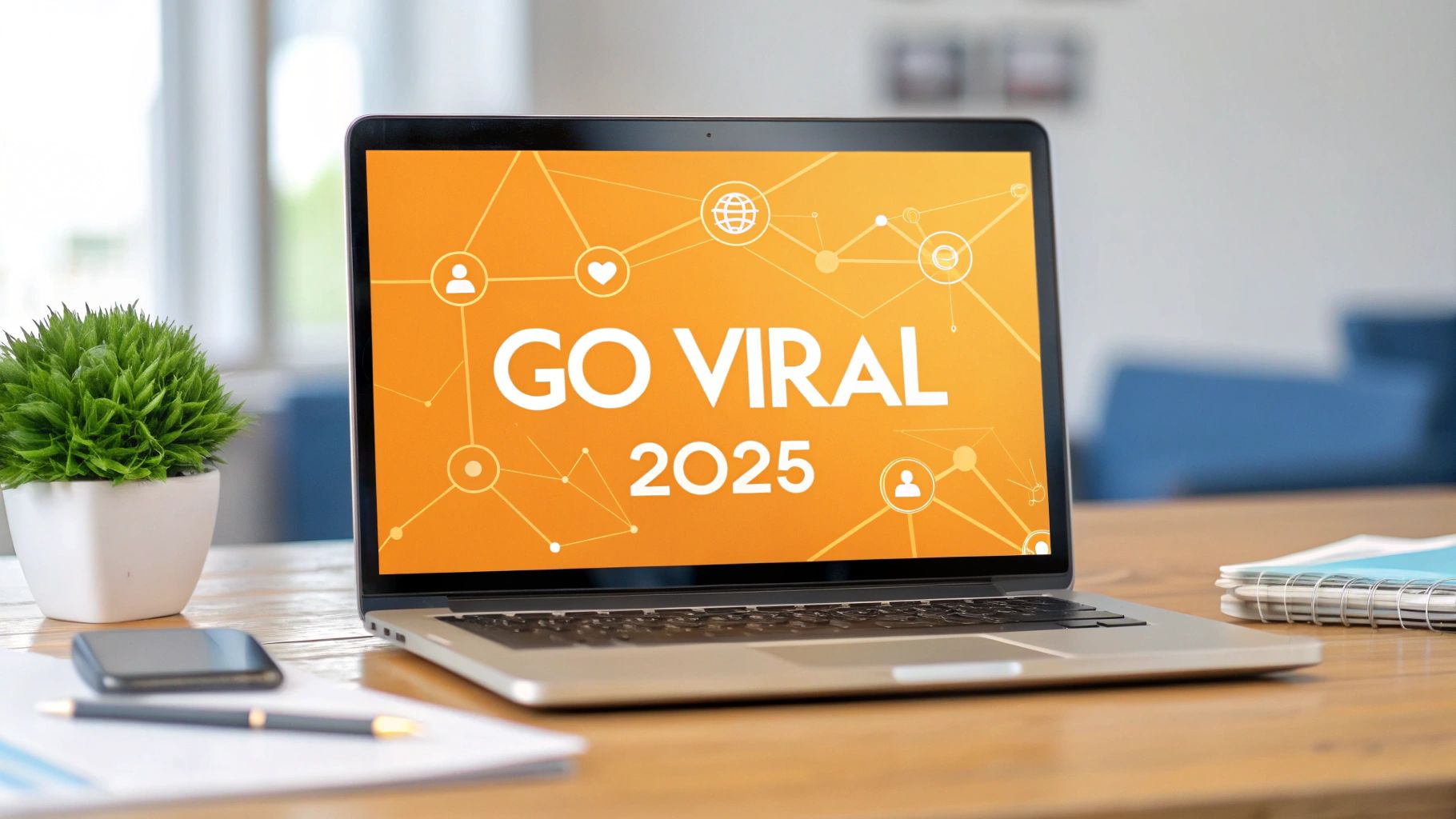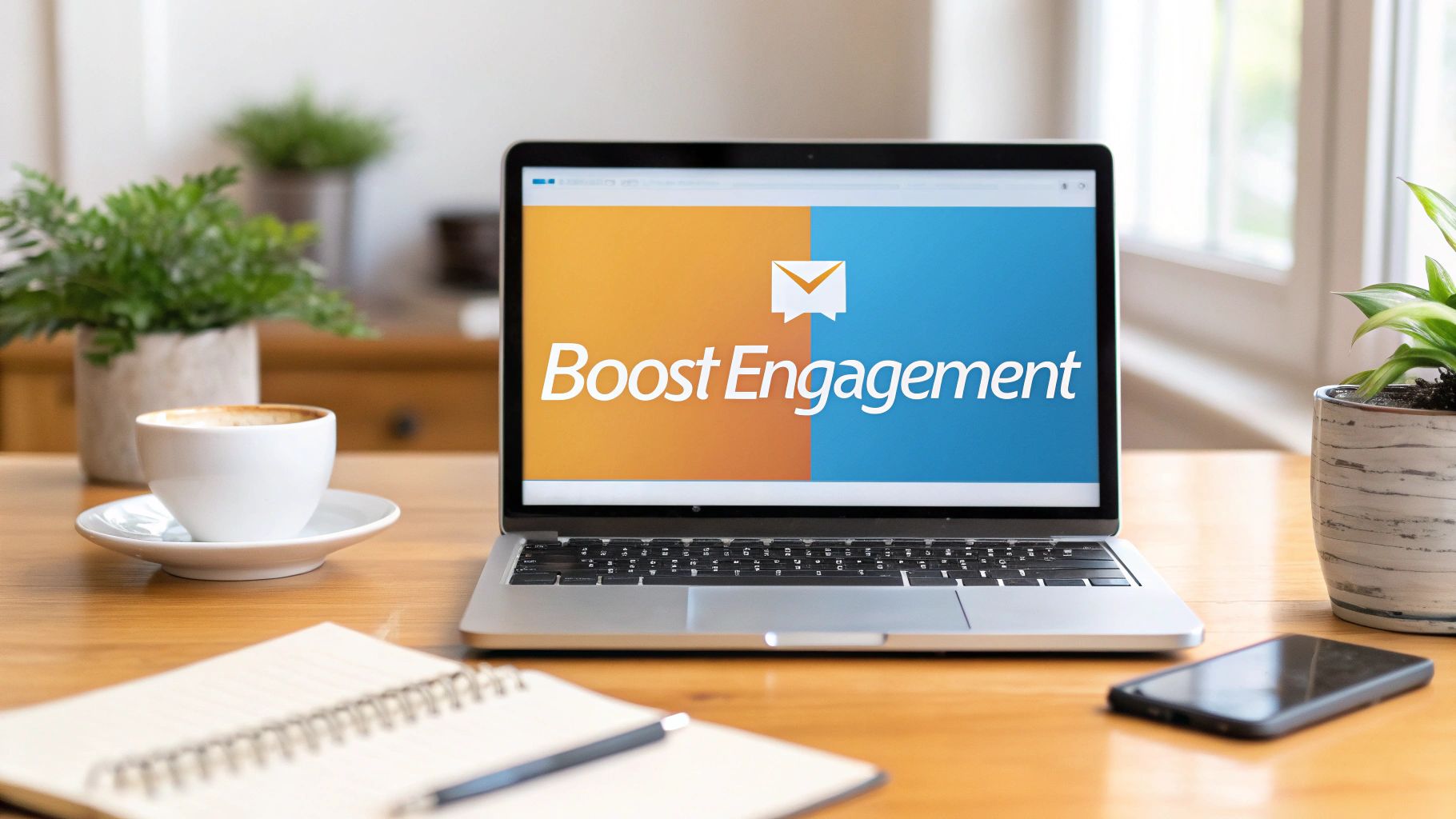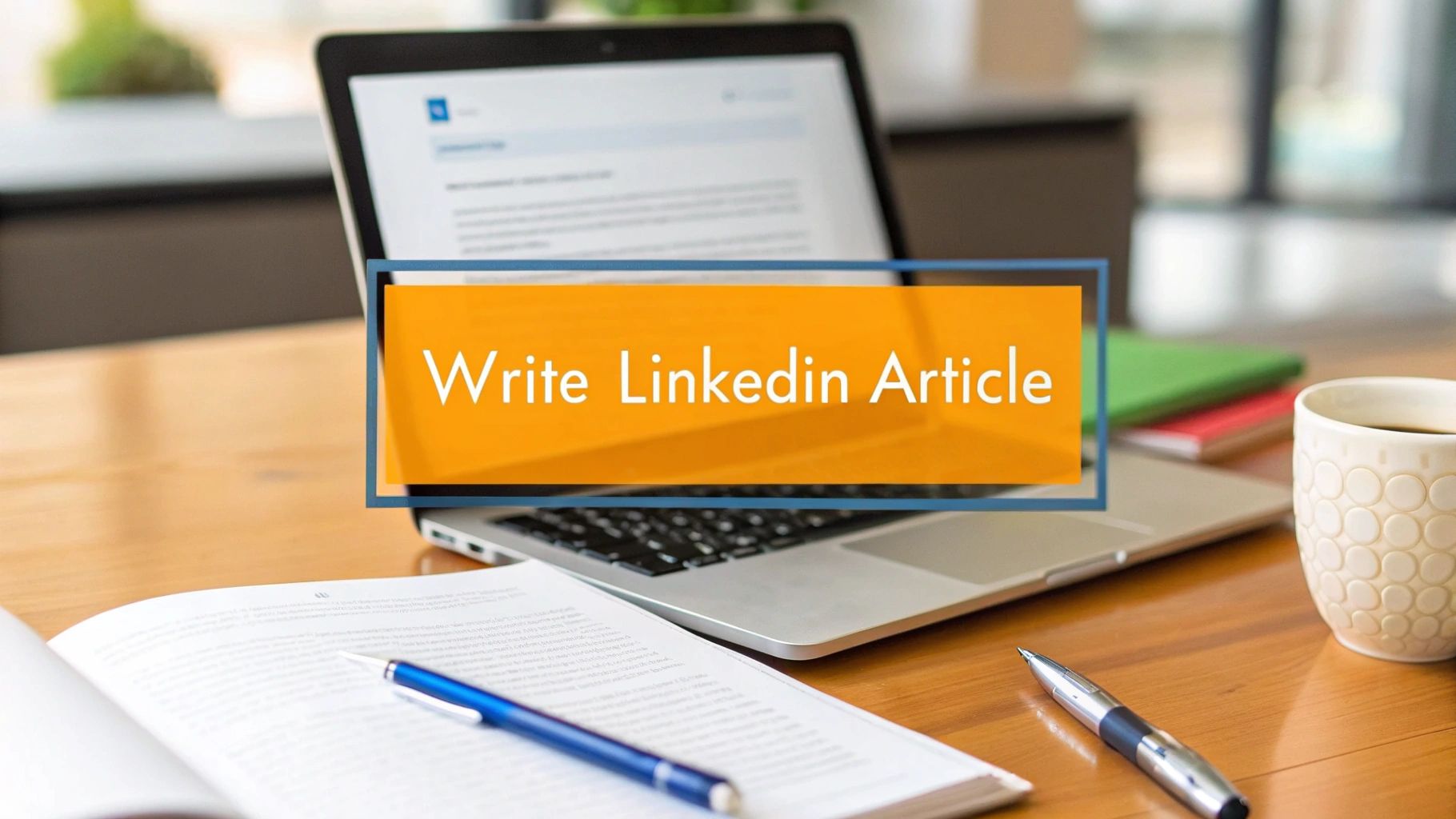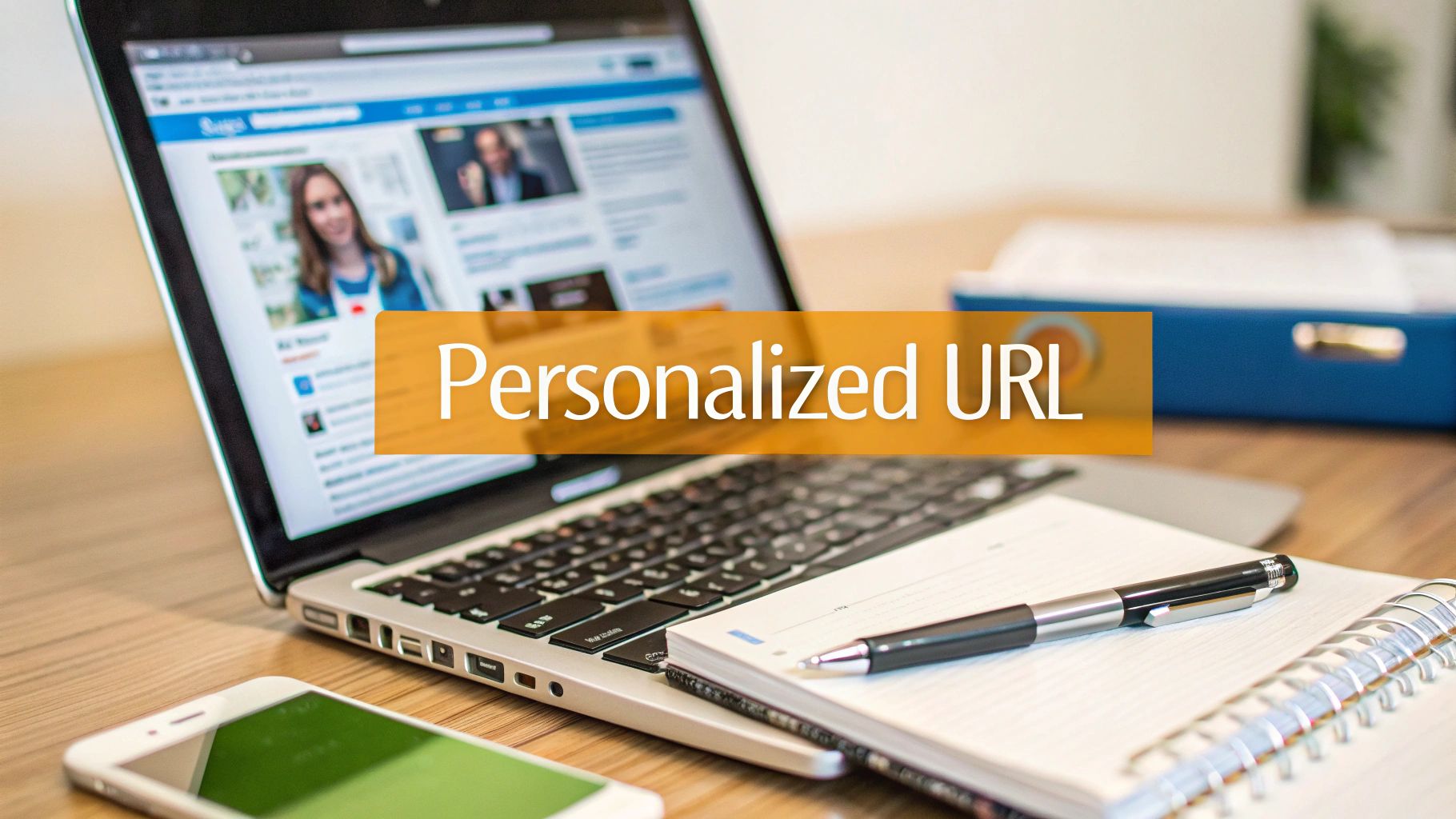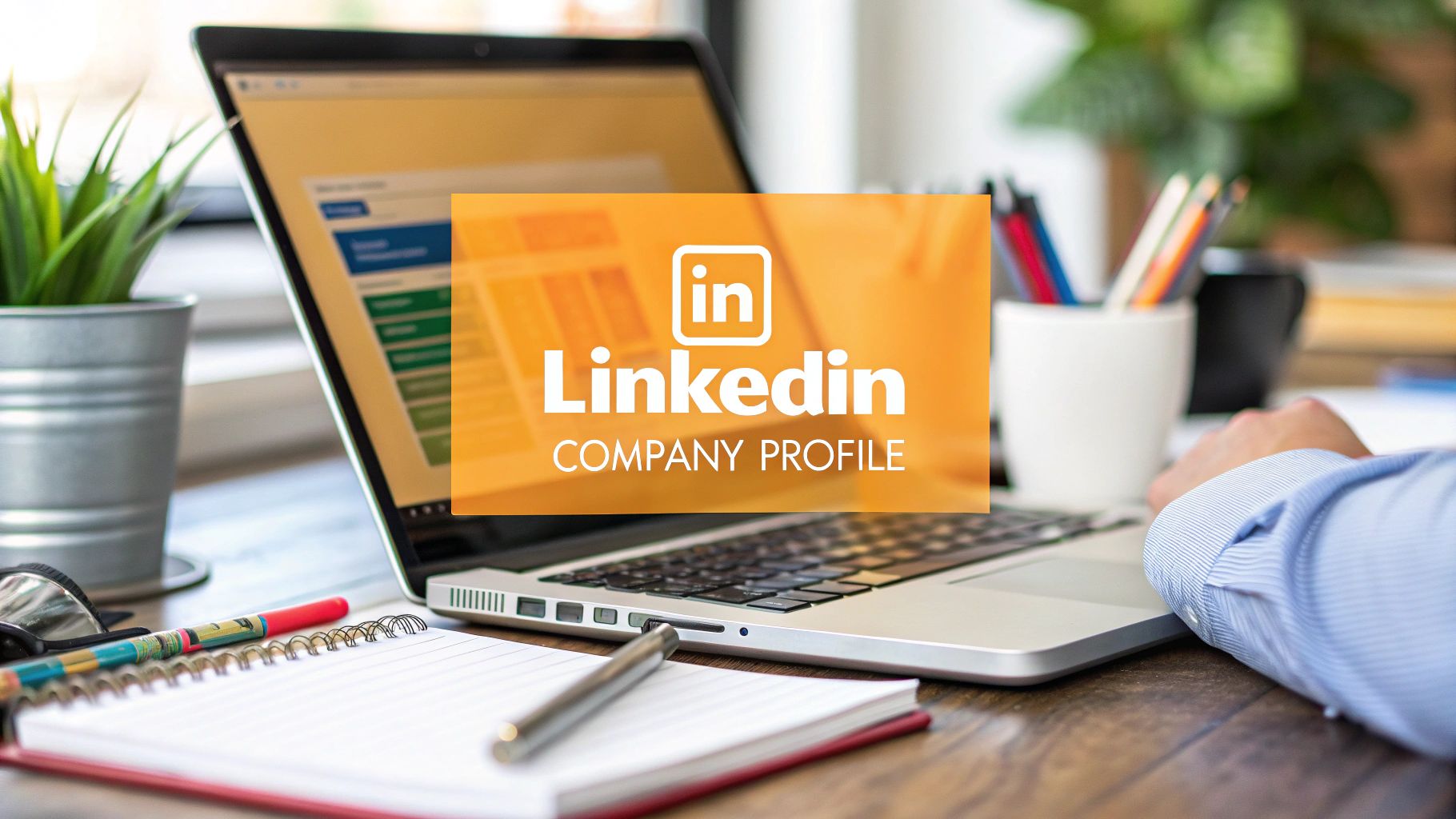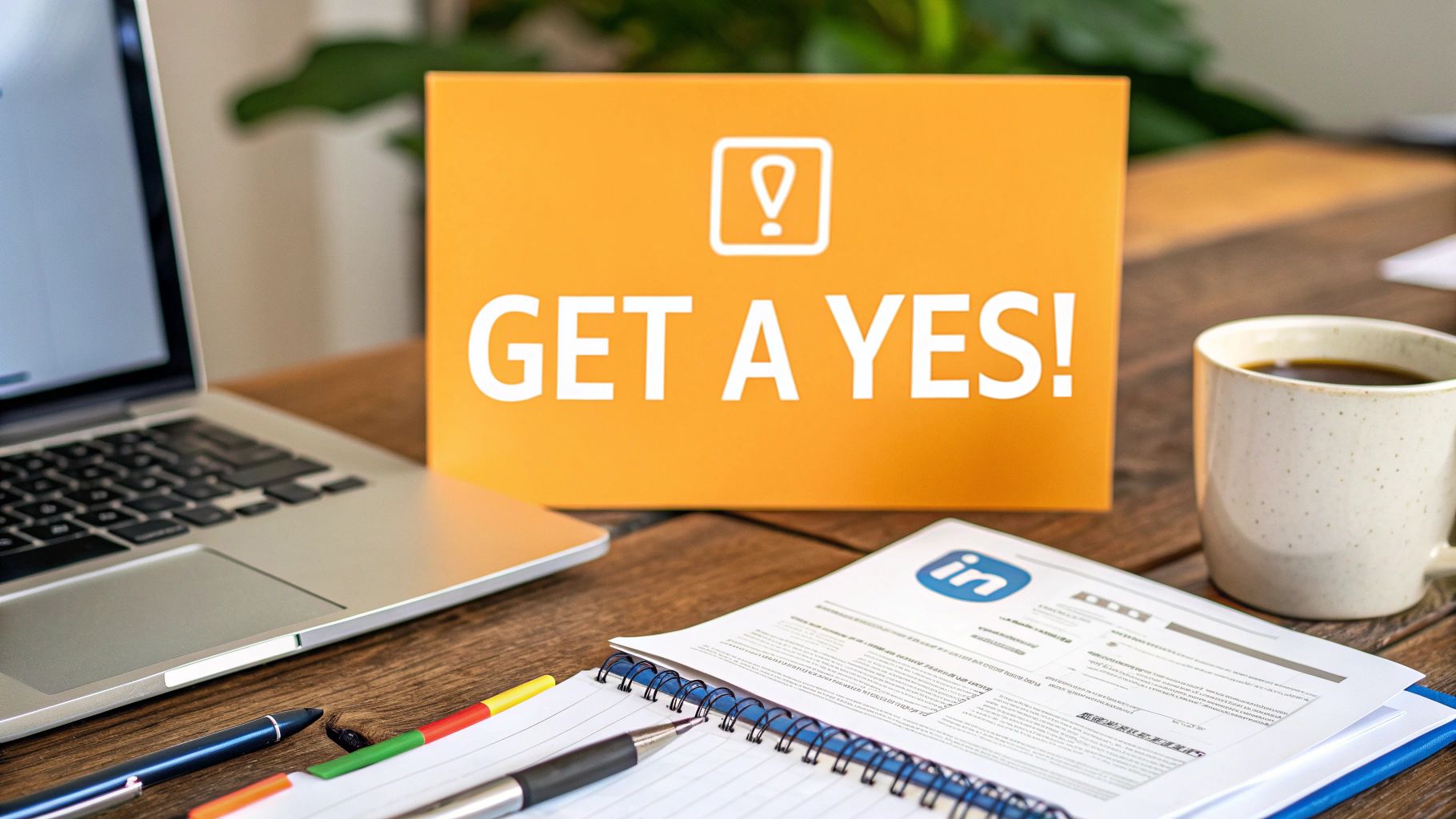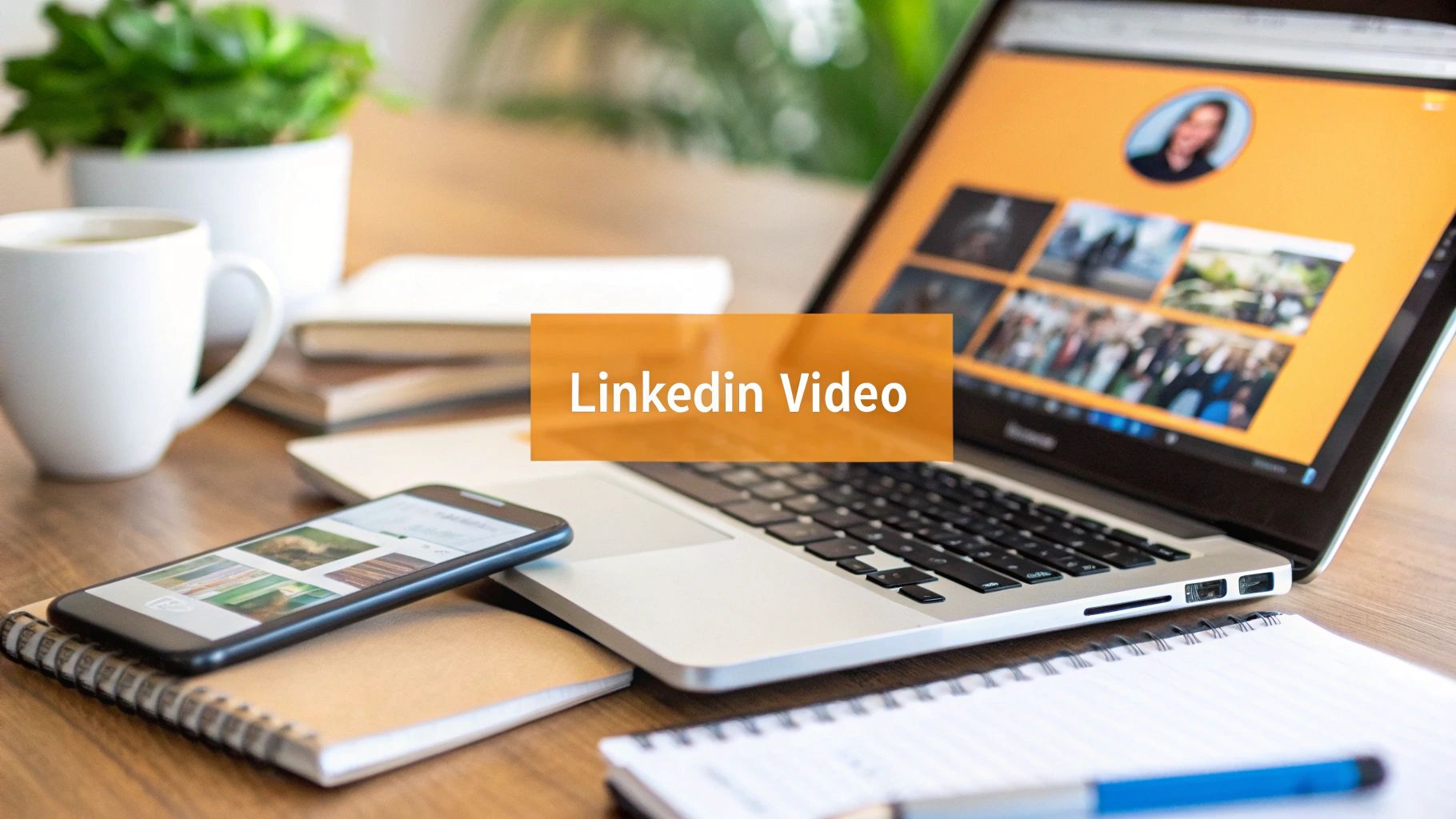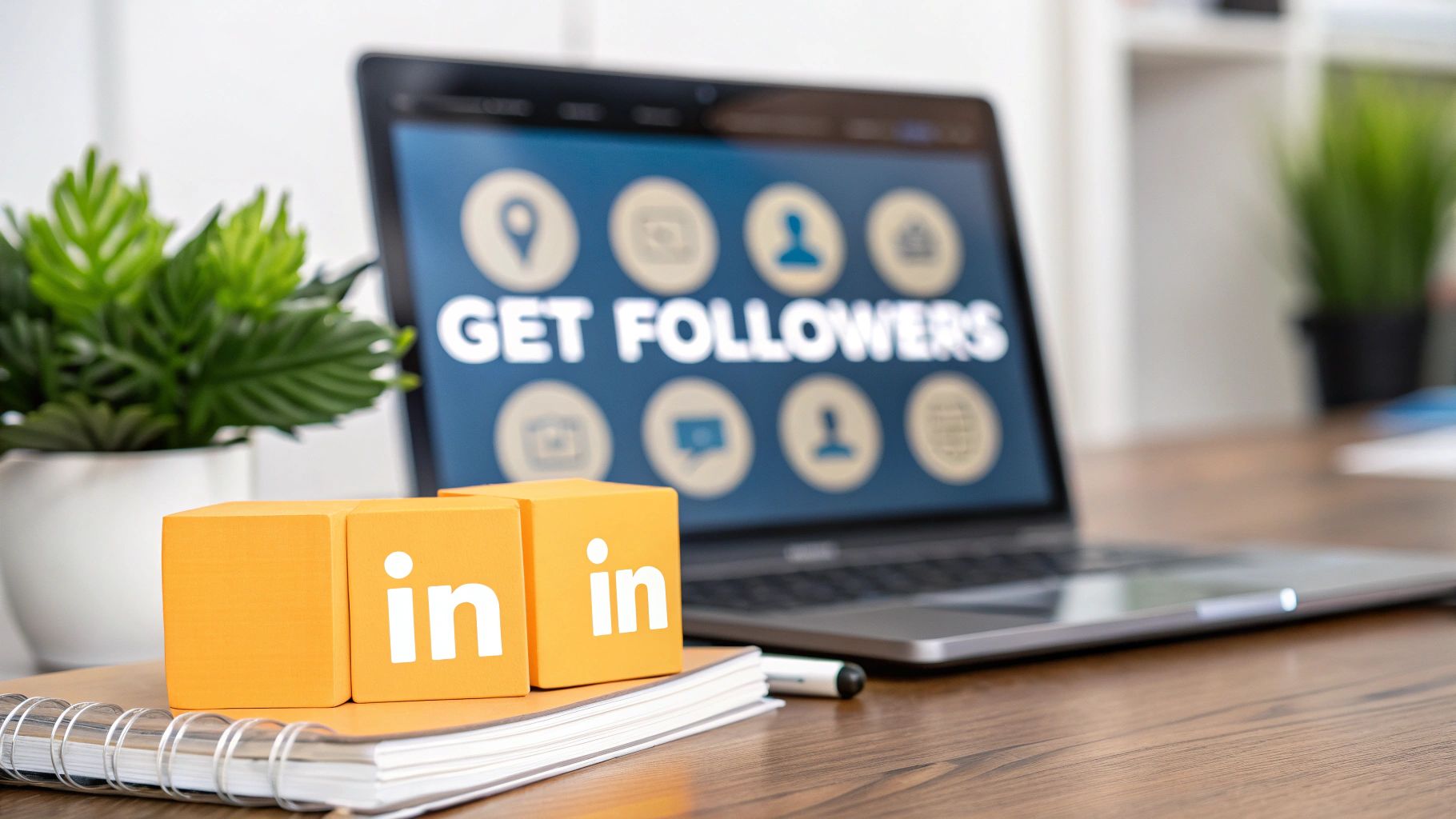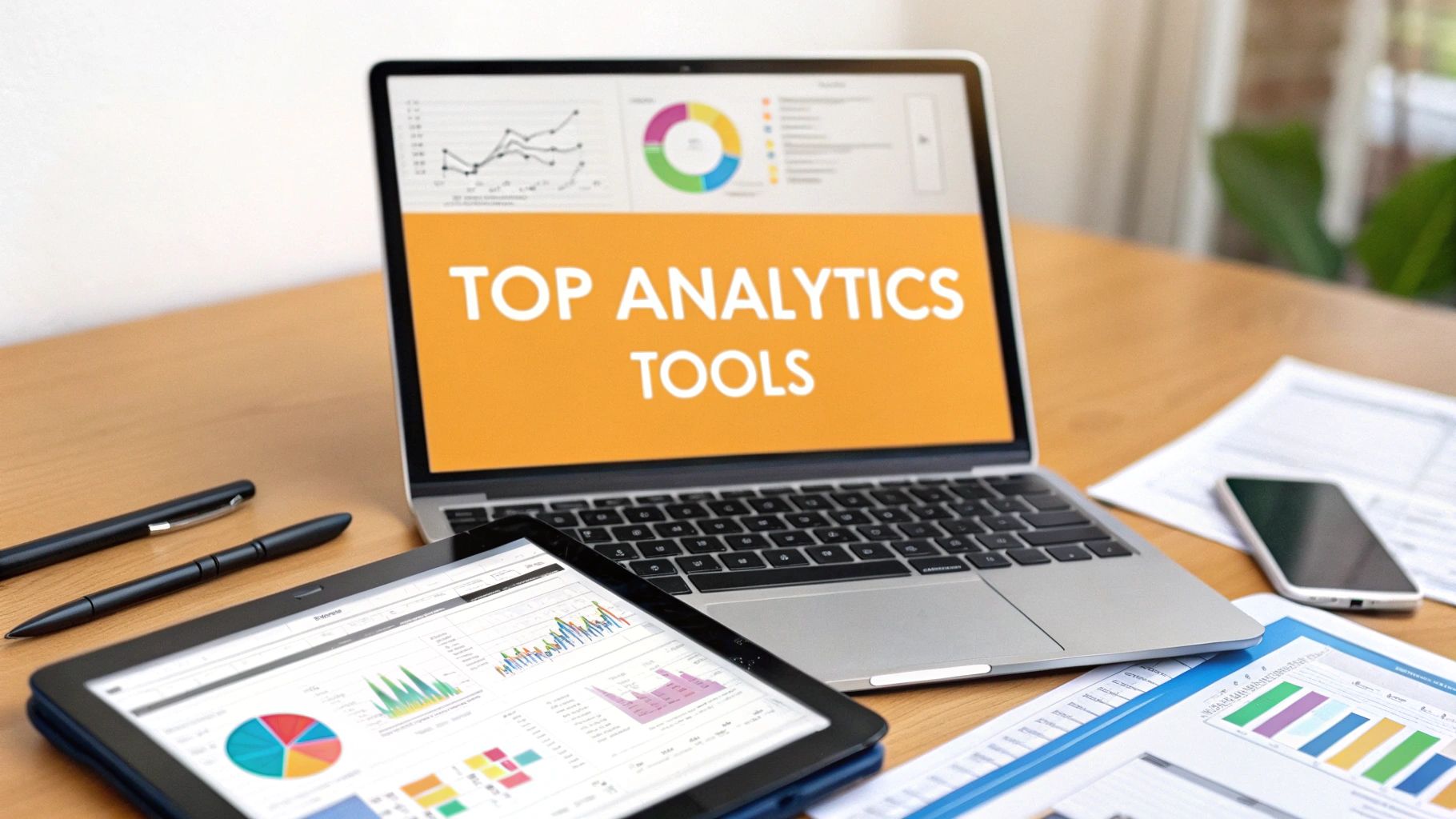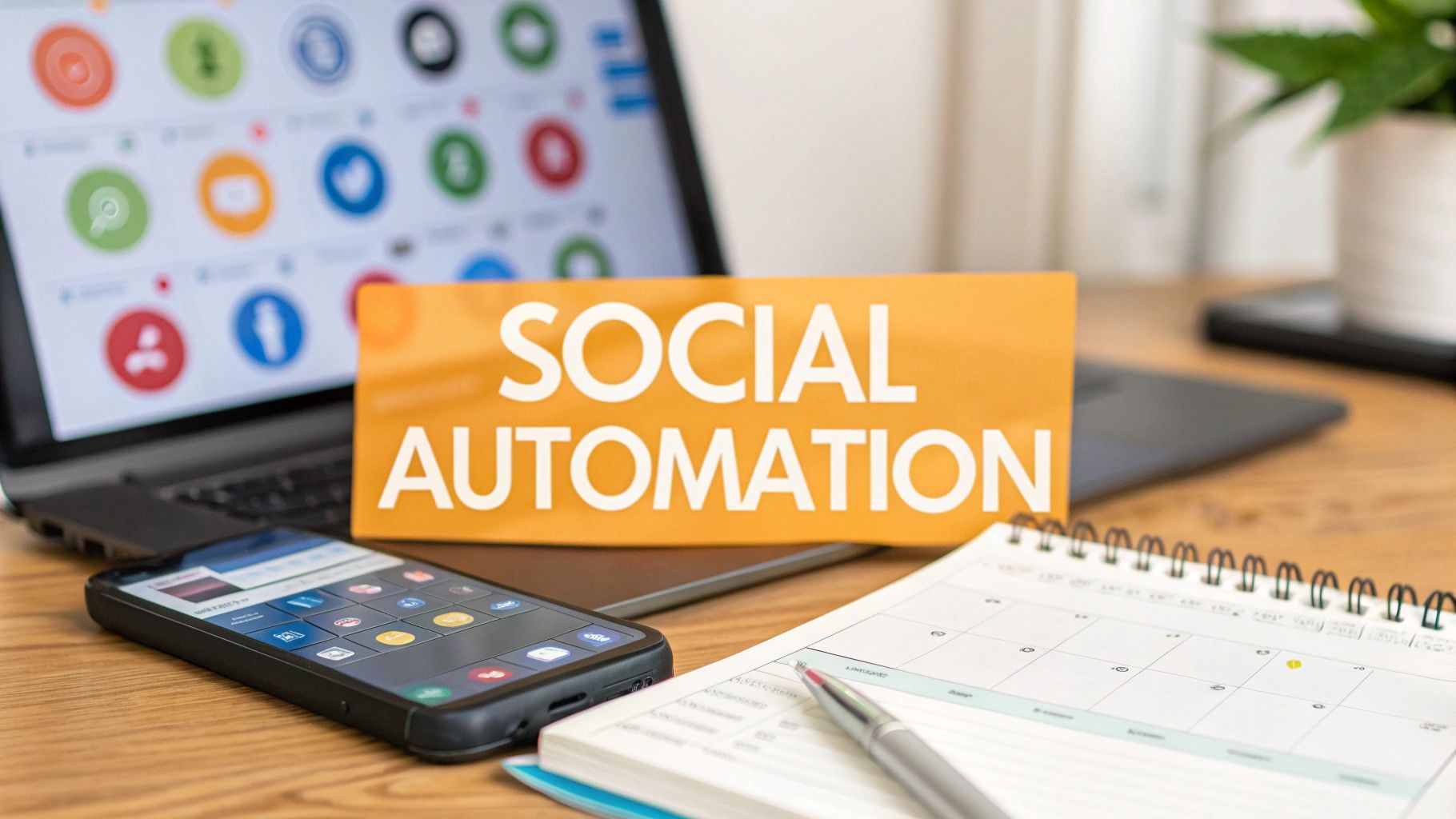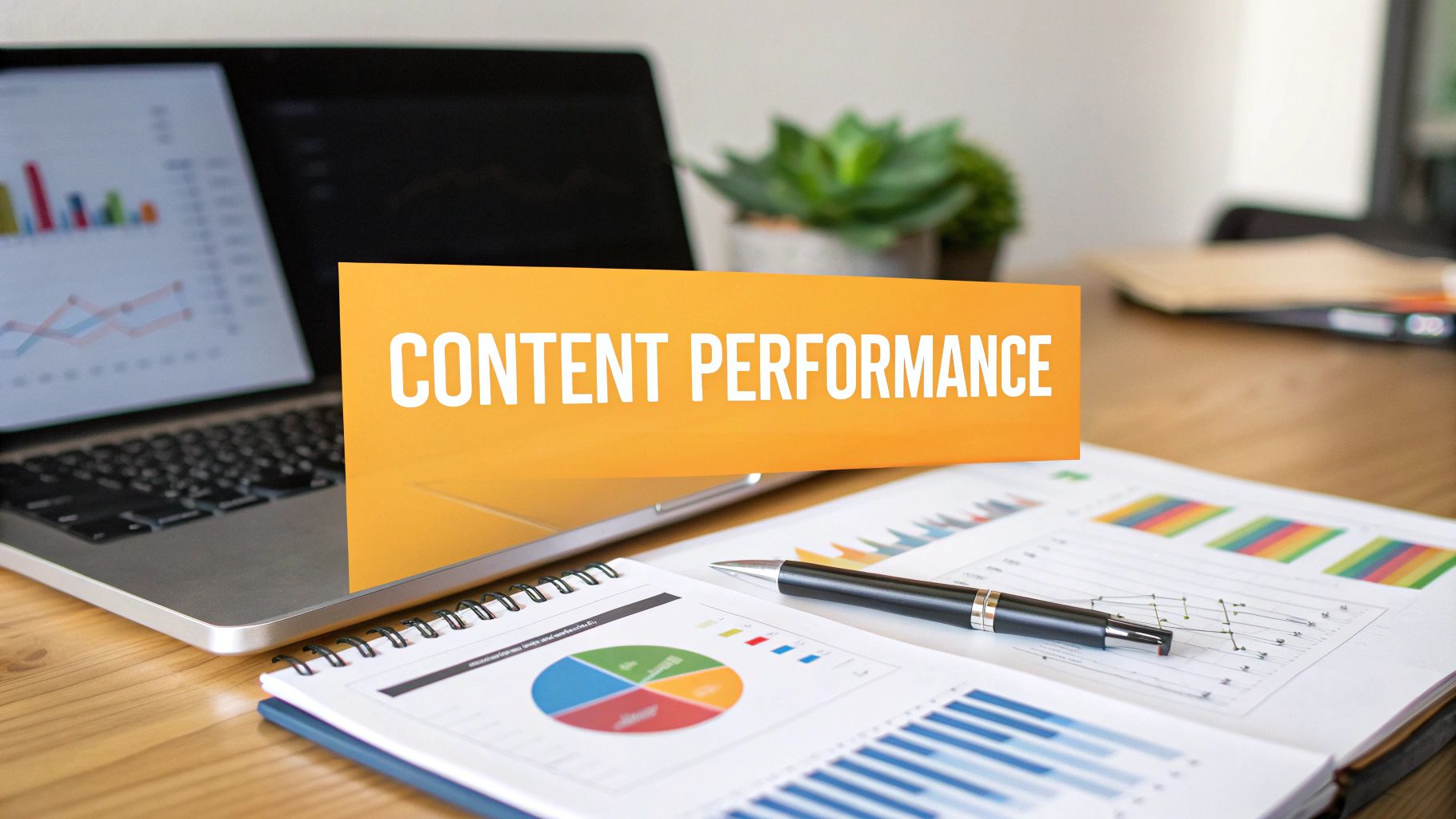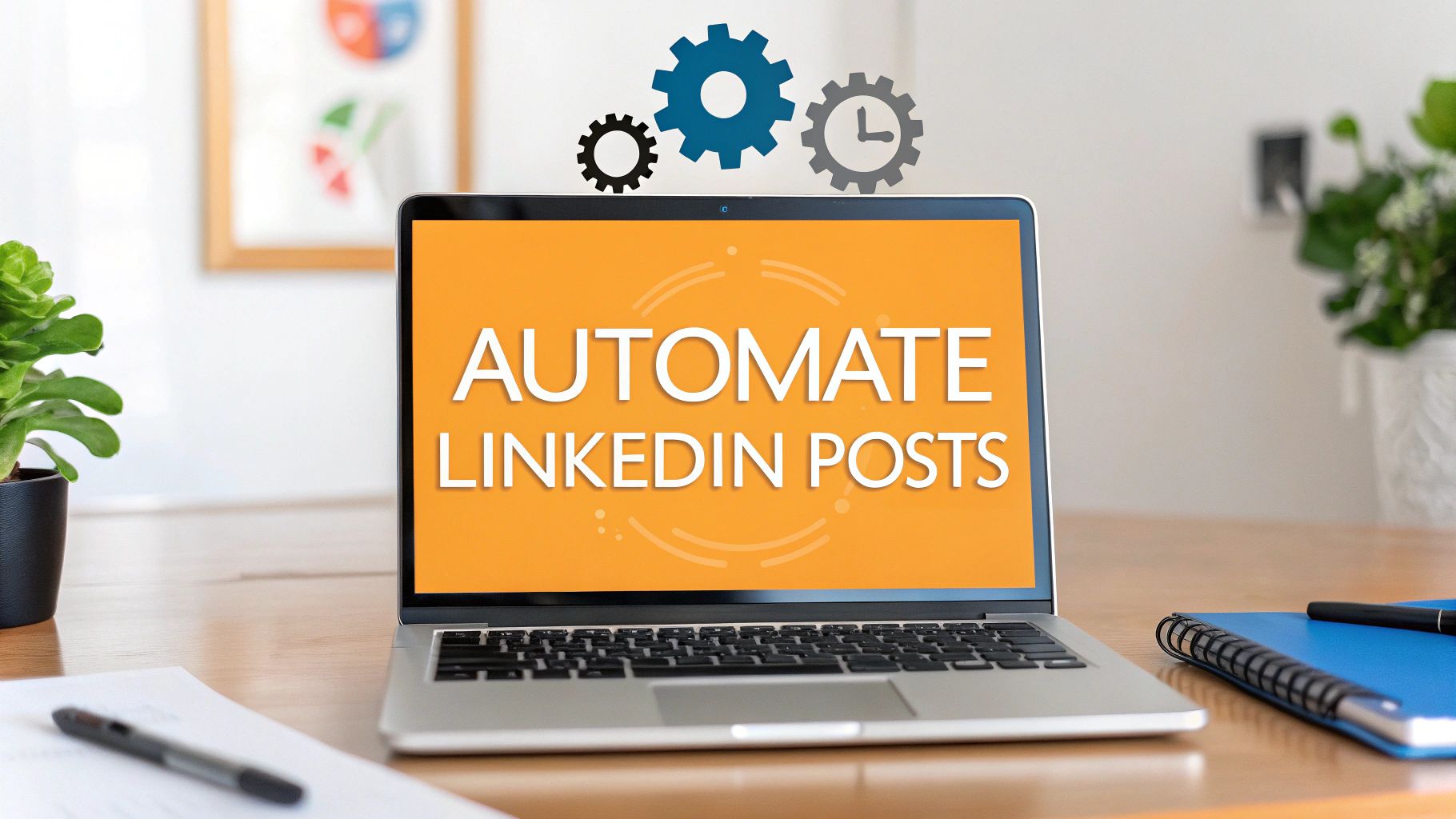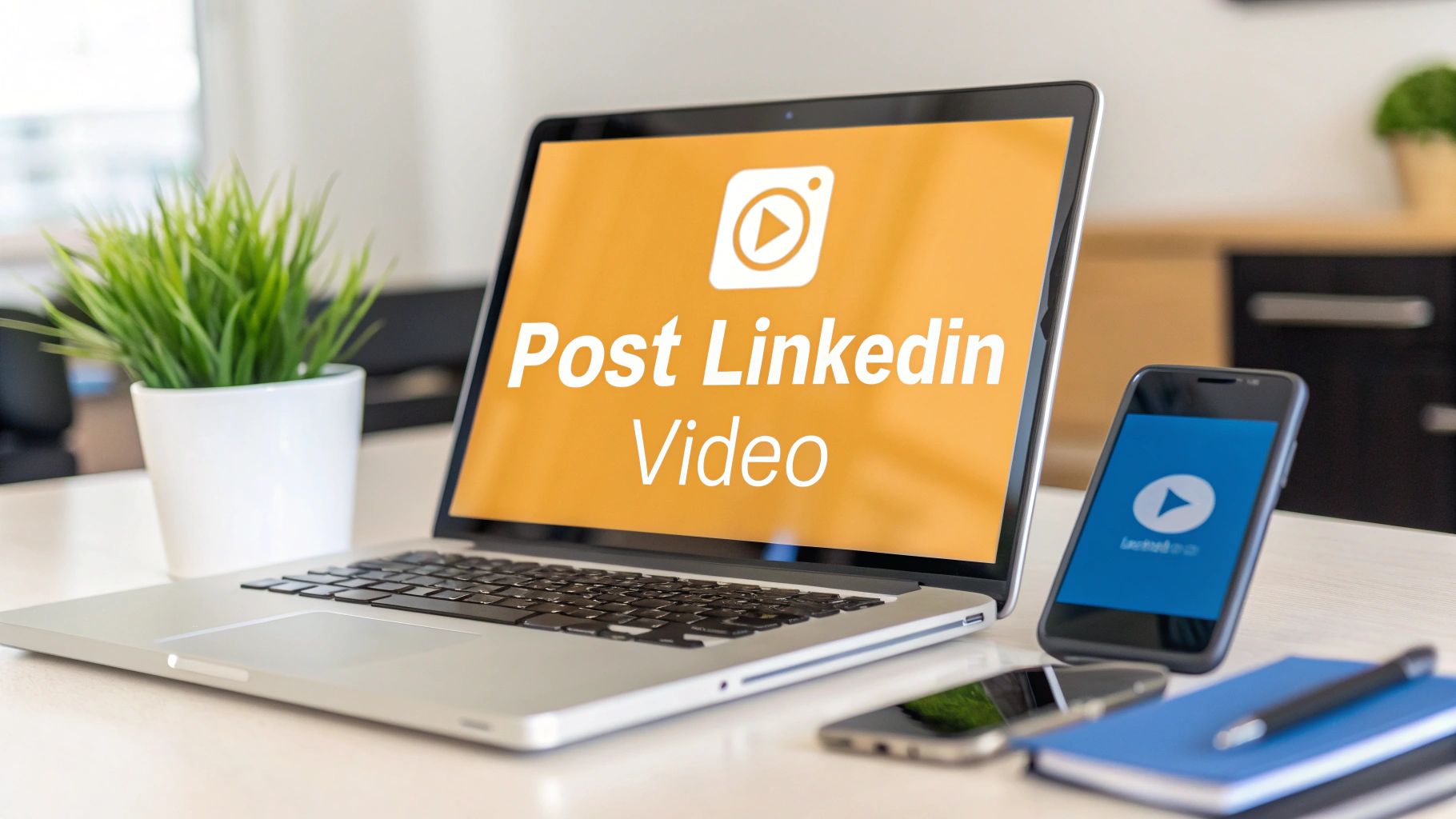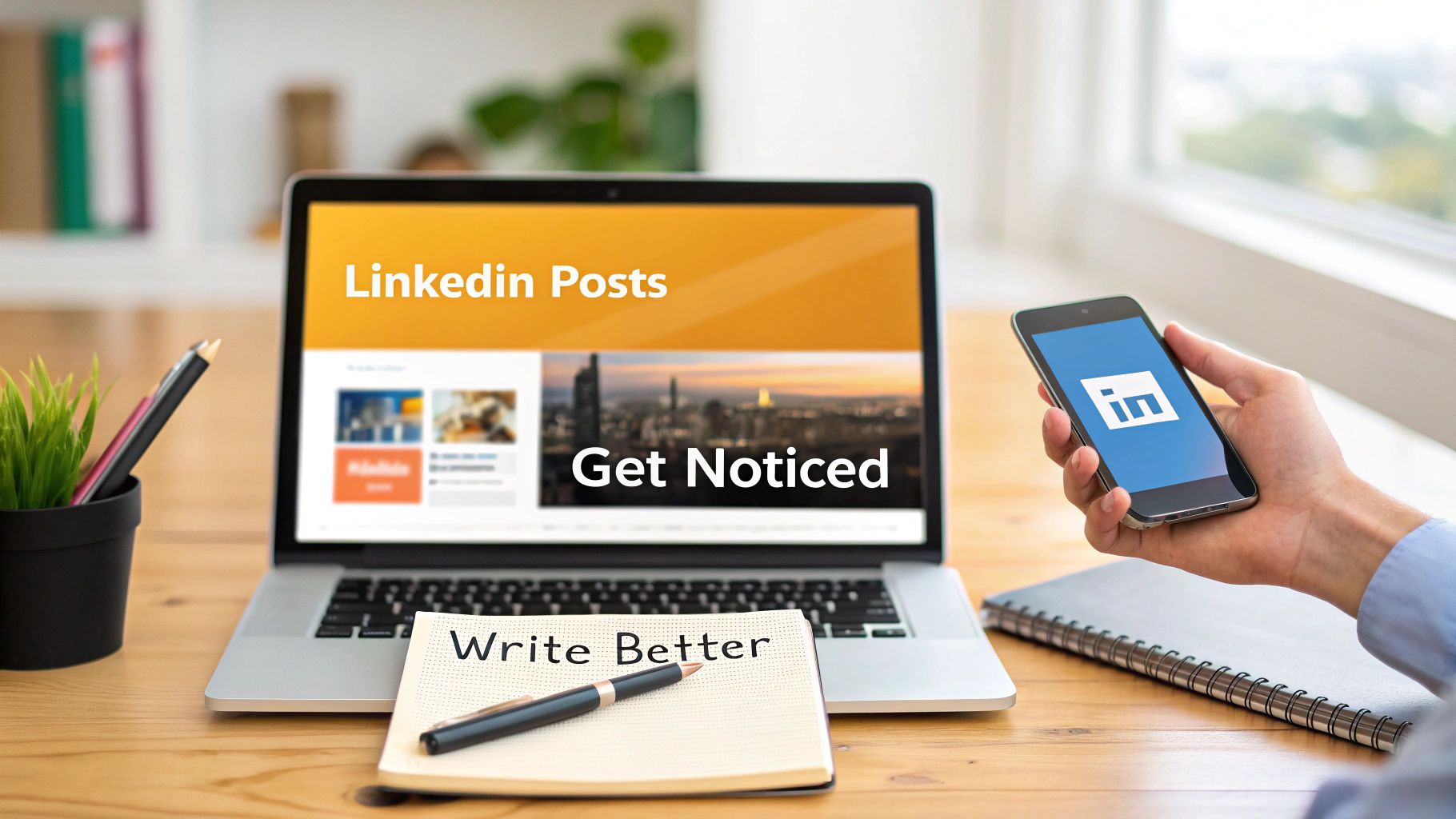If you want to grow on LinkedIn, you have to stop thinking of your profile as a digital resume. It’s not static. It’s a living, breathing hub for opportunities, and it needs to be treated like one.
When you nail this—combining a killer profile with consistent, valuable content—you start building a network that brings opportunities to you.
Build a Profile That Actually Attracts People
Think of your LinkedIn profile as the digital handshake that happens before any real conversation. It’s your professional landing page. If it’s not turning visitors into followers, connections, or leads, you’re missing a huge piece of the puzzle.
A profile that truly works for you does three things, and does them well:
- It clarifies your value, instantly. People know who you are, what you do, and why they should stick around.
- It builds trust. Your expertise, experience, and the recommendations you’ve earned all signal that you know your stuff.
- It makes people want to connect. It tells a story that pulls them in and makes them curious about your work.

Craft a Headline That Sells, Not Just States
Your headline is the most valuable piece of real estate on your entire profile. It follows you everywhere—comments, connection requests, search results. So, ditch the boring, default job title. "Marketing Manager at Company X" tells me nothing.
Instead, focus on the problem you solve. For example, a content writer could go from a generic title to something like: "I help SaaS startups drive organic growth with SEO-focused content that converts." See the difference? One is a label; the other is a solution.
Write an "About" Section That Tells Your Story
This is your chance to be human, not just a list of job duties. The 'About' section is where you connect with people. Use a conversational tone to talk about your professional journey, what you’re passionate about, and the results you’ve delivered.
But don't just write a wall of text. Break it up. Start with a hook that grabs their attention. Use short paragraphs and maybe some bullet points to highlight key skills or wins. And please, end with a clear call to action. Tell people what to do next—connect, visit your site, or send you a message. This is a massive part of learning how to optimize your LinkedIn profile for real engagement.
Your LinkedIn profile isn't just a list of your past jobs. It's the central hub of your professional identity. It’s where you articulate your expertise, share your perspective, and build the foundation for every opportunity that comes your way.
Maximize Your Visuals
First impressions are almost always visual. A blurry selfie or that default blue banner just screams "I don't care."
Invest in a decent, professional headshot. You should look approachable and confident. Your background banner is another golden opportunity. Don't waste it on a generic stock photo. Jump into a free tool like Canva and create a custom banner that highlights your core service, a major accomplishment, or your personal brand’s tagline. It makes your profile look intentional and polished. Your profile is central to your professional identity, so learn how to build a personal brand that actually gets you noticed.
Be Strategic with Your Skills and Experience
That skills section isn’t just for dumping keywords. It’s where others can vouch for your expertise. Make sure to pin your top three most important skills—the ones you absolutely want to be known for.
When you get to your work experience, don’t just copy and paste from your resume. For each role, write a short story. Briefly explain your main responsibilities, but focus on your accomplishments. Use bullet points with real numbers, like "Increased lead generation by 45% in six months" or "Managed a project budget of $500,000, delivering on time and under budget." Concrete numbers are powerful. They make your experience real and tangible for anyone checking you out.
Grow a Network That Creates Real Value
So you’ve got a killer, optimized profile. That’s the first piece of the puzzle. Now, you need to connect it to the right people.
Let's be clear: a massive connection count on LinkedIn is just a vanity metric. What really moves the needle and creates actual opportunities is the quality of that network. It’s time to ditch the old-school "spray and pray" method of connecting with anyone who breathes. Real growth comes from building a network of people who are relevant to your goals and genuinely engaged.
This is all about shifting your mindset from "collecting connections" to "cultivating relationships." Every single connection request you send should have a clear purpose behind it. Are you reaching out to a potential client? A mentor? A peer whose work you admire? Knowing your "why" is everything.
Quality Over Quantity Is the Only Rule
Sending a blank, generic connection request is the professional equivalent of junk mail. It screams, "I haven't spent 10 seconds looking at your profile," and gives the other person absolutely no reason to accept.
People are busy. A thoughtless request is an easy "ignore." Your job is to make it a no-brainer for them to click "accept."
This just takes a tiny bit of upfront effort. Before you hit that "Connect" button, spend two minutes on their profile.
- Did they just post something insightful you can comment on?
- Do you have a shared connection or a past employer in common?
- Is there a mutual interest or skill that stands out?
With that little piece of intel, you can write a short, personal note that immediately cuts through the noise. This small gesture dramatically boosts your acceptance rate because it shows you’re a real person who’s paying attention.
For a deeper dive, our guide on how to network effectively breaks down even more of these strategies.
Personalize Your Connection Requests
Let's make this real. Say you want to connect with a marketing director at a SaaS company you’ve been following.
The Generic (and bad) Approach:
No message at all. Just a cold request.
The Personalized (and great) Approach:
Hi [Name], I really enjoyed your recent post on product-led growth strategies. Your point about user onboarding being a key marketing lever was spot on. I’m also in the SaaS marketing space and would love to connect and follow your work.
See the difference? That simple, 3-sentence note shows you've done your homework, offers a genuine compliment, and explains why you want to connect. It’s respectful, professional, and it works.
Tap into Niche Communities with LinkedIn Groups
Don't just focus on one-on-one connections. LinkedIn Groups are a goldmine for finding your people, but so many users overlook them. These are focused communities built around specific industries, job functions, or interests, putting you in a virtual room with thousands of professionals in your niche.
Of course, just joining a group does nothing. You have to participate.
- Answer questions: Jump in and share your expertise when someone asks for help.
- Start discussions: Pose a thoughtful question to get a conversation rolling.
- Share valuable content: Found a great article? Post it and add your two cents.
When you consistently show up and add value in these groups, you naturally position yourself as a helpful expert. Other members will start checking out your profile and connecting with you. It's a fantastic way to grow your network with highly relevant people who already share your professional interests.
With the platform exploding from 644 million members in 2019 to a projected 1.15 billion by early 2025, these communities are more vibrant than ever. This data, highlighted in a report on LinkedIn's massive user growth on cognism.com, shows just how big the opportunity is. This kind of strategic engagement is the secret to sustainable growth on LinkedIn.
Create Content People Genuinely Want to Read
If your profile is the polished front door, your content is the conversation that invites people inside. Look, a great profile is table stakes, but it's not enough on its own. You need to give your network a real reason to pay attention, and that happens when you start sharing what you know. This is where you shift from just watching to being an active voice in your field.
Don't get caught up in the "going viral" trap. That’s a fast track to burnout. The real goal is to build a sustainable content engine—a rhythm for consistently sharing insights that spark conversations and build your reputation over time.
And the audience is definitely there. The professional world on LinkedIn is booming, creating a huge appetite for quality content.

Just look at those numbers. The jump from 644 million users back in 2019 to a projected 1.15 billion by 2025 is staggering. That's a massive opportunity for anyone willing to step up and share their expertise.
Find Your Content Pillars
Before you even think about writing, you have to know what you’re going to talk about. This is where your content pillars come in. These are the 3-5 core topics you know inside and out and are genuinely passionate about. They're your guardrails, keeping your content focused and helping you build a clear, memorable personal brand.
For example, a software developer might focus on:
- Frontend Development Techniques
- Career Growth in Tech
- Productivity Hacks for Coders
And a marketing consultant could build their brand around:
- SaaS Content Strategy
- Product-Led Growth
- Building a Personal Brand
Once you have these pillars, the dreaded blank page becomes a lot less intimidating. You suddenly have a framework that makes generating relevant ideas for your audience feel almost effortless.
Mix Up Your Content Formats
LinkedIn isn't a one-trick pony. Different post formats achieve different things, and sticking to just one is like trying to build a house with only a hammer. A healthy mix of formats keeps your feed fresh and gives your followers more ways to engage.
LinkedIn Content Format Performance
To get the most out of your content, you need to understand which format works best for the message you're trying to send. Some formats are built for quick hits, while others are perfect for deep dives.
| Content Format | Potential Reach | Best For | Pro Tip |
|---|---|---|---|
| Text-Only Posts | High | Sharing quick insights, telling personal stories, or asking engaging questions. | A killer first line is everything. Hook them in the first one or two sentences to stop the scroll. |
| Image Posts | Medium-High | Visual storytelling, sharing interesting data, or celebrating team wins. | Use real, high-quality photos. Ditch the generic stock images if you can—authenticity builds trust. |
| Carousels (PDFs) | Very High | Breaking down complex topics into digestible slides, tutorials, or "how-to" lists. | Your cover slide has to pop. Think of it like a mini-presentation title that clearly states the value inside. |
| Polls | High | Sparking instant engagement, gathering audience opinions, and doing quick market research. | Keep the poll simple and the question interesting. Always jump into the comments to fuel the discussion. |
Playing around with these formats is the best way to figure out what your specific audience loves. Keep an eye on your analytics—the comments and shares will tell you what’s hitting the mark.
Share Authentic Stories and Insights
At the end of the day, people connect with other people, not with corporate buzzwords or faceless logos. The content that truly flies on LinkedIn almost always comes from personal experience. This is your chance to be human.
Don't just re-share industry news; give us your take on it. What does that new trend really mean for someone in your shoes? Did you learn a hard lesson from a project that went sideways? Sharing those real-world experiences—wins and losses—is what makes you relatable and trustworthy.
A great post doesn't just broadcast information; it starts a conversation. It should feel honest, relevant, and maybe even a little vulnerable. Always try to end your posts with a question to invite people to share their own thoughts.
This simple shift turns your content from a monologue into a dialogue. Engaging in those conversations is what the algorithm loves, and it’s how you build a real community.
For a deeper dive into crafting posts that truly hit home, it's worth exploring the art of creating engaging content that connects. Ultimately, a solid plan built on authenticity and real value is the most reliable way to grow on LinkedIn.
Turn Comments and Conversations into Connections
Hitting "post" is just the start. If you publish content and then disappear—what I call the "post and ghost"—you're leaving a massive growth opportunity on the table. Real community isn't built from a monologue on your feed; it’s built in the comment sections. Both on your posts and on others'.
This is where you stop being just a broadcaster and start being a real participant in your industry's conversation. The LinkedIn algorithm absolutely loves this. When a post sparks a good discussion, the platform shows it to more people. Engagement isn't just for show; it's the fuel for your reach.

The Art of the Thoughtful Comment
Leaving comments on other people's posts is probably the most underrated strategy for learning how to grow on LinkedIn. A "Great post!" is basically invisible. It adds nothing and gets you nowhere. If you want to stand out, your comments have to be actual contributions.
The real goal is to leave a comment so insightful that people stop scrolling, read it, and think, "Who is this?" That's the curiosity that leads to profile views and connection requests from people who are genuinely interested in what you do.
Here's a simple framework I use for comments that actually get noticed:
- Acknowledge: Start by referencing a specific point they made. "I really agree with what you said about..."
- Add: Build on it with your own perspective, a quick story, or a follow-up question. This is where you add your value.
- Applaud: End with a genuine compliment. "Fantastic insight, thanks for sharing this."
This little formula turns a passive 'like' into an active interaction that shows you're a thinker in your space.
Your Daily Routine for Smart Engagement
You don't need to live on LinkedIn to make this work. A focused 15-20 minutes a day can make all the difference.
- Check in on Key People (5 minutes): Have a list of 5-10 industry leaders, dream clients, or peers you respect. Start your day by checking their posts and leaving at least one thoughtful comment.
- Scan Your Notifications (5 minutes): Never ignore comments on your own stuff. A quick reply shows you're paying attention and makes people more likely to engage again.
- Browse the Feed (5 minutes): As you scroll, find 2-3 other posts that catch your eye and drop a quality comment.
This habit is simple, doesn't take over your schedule, and keeps you consistently visible.
Engagement is a two-way street. If someone takes the time to comment on your post, acknowledge them. Meaningful interactions build relationships and encourage more engagement in the future. Why wouldn't you reply?
Managing Comments on Your Own Content
When people comment on your posts, they're giving you a gift. Seriously. They’re boosting your post’s visibility and starting a conversation for you. Your job is just to keep it going.
Don't just 'like' their comment. Reply to it. Better yet, ask a follow-up question to keep the ball rolling. For instance, if someone shares a related experience, you could say: "That's a great point. How did you handle [specific challenge] when that happened?"
This simple act of replying does a few powerful things at once:
- It doubles the comment count, which is a great signal to the algorithm.
- It makes the original commenter feel seen and appreciated.
- It invites others to join in, creating a snowball effect of discussion.
Remember, that first hour after you post is golden. If the algorithm sees you're actively replying to early comments, it's far more likely to push your content out to a wider audience. Being present right after you hit publish can completely change a post's trajectory. This is how you turn followers into a real community—one thoughtful comment at a time.
Use Analytics and AI for Smarter Growth
Making great content and connecting with your network is half the battle, but if you're not paying attention to the data, you’re flying blind. To really speed up your growth on LinkedIn, you have to stop guessing what works. It's time to let the numbers guide your decisions.
This is where analytics and AI come in, turning your content strategy from a shot in the dark into a precise science.
Every time you post, you're creating a goldmine of data. LinkedIn’s own analytics dashboard is the perfect place to start digging. Forget just chasing likes; you need to understand the story your numbers are telling you. This data reveals what your audience actually cares about, not just what you think they want to see.
Figuring Out Your LinkedIn Analytics
Jumping into your analytics for the first time can feel like a lot. Let's cut through the noise and focus on what really matters. Don't get distracted by vanity metrics; zero in on the numbers that show genuine engagement and a real connection with your audience.
Here are the core metrics that tell you the most:
- Impressions: This is simply how many times your post appeared in someone's feed. It’s a solid measure of your overall reach, but it doesn't paint the full picture.
- Engagement Rate: This is the big one. You get this number by dividing your total engagements (likes, comments, reposts) by your impressions. A high engagement rate is a clear sign that your content is hitting home.
- Follower Demographics: Who's actually following you? LinkedIn breaks down their job titles, industries, and locations. This is your reality check—are you attracting the right people?
Make a habit of checking these numbers weekly. You'll start to notice patterns. Did that raw, text-only post about a personal mistake completely blow your polished carousel out of the water? That's a huge clue. It means your audience is craving authenticity, and you should give them more of it.
For a deeper dive, check out our guide on how to measure content performance and use those ideas here.
Using AI as Your Creative Partner
Once you know what connects with your audience, AI can be your secret weapon to create more of it, much faster. A tool like RedactAI isn't here to replace your voice—it's here to amplify it. Think of it less like a ghostwriter and more like a brainstorming buddy who can help you bust through writer's block and sharpen your ideas.
Instead of staring at that blinking cursor on a blank page, use AI to get the ball rolling.
The real magic of AI isn't having it write for you, but getting it to think with you. It can spitball angles you missed, polish your messy first drafts, and help you spin one idea into several different posts.
For instance, you could give an AI tool a simple prompt like:
- "Brainstorm five hooks for a LinkedIn post about the biggest mistake I made in my first year of business."
- "Rewrite this paragraph about project management to sound more confident."
- "Take these bullet points from a client success story and turn them into a compelling narrative for a LinkedIn post."
This approach can save you hours, freeing up your brainpower for the stuff AI can’t do—building real relationships and sharing your unique human experience.
By combining the human insights from your analytics with the speed of AI, you create a powerful cycle. Data tells you what to create, and AI helps you create it better and faster. This is the modern playbook for growing on LinkedIn in a way that’s both strategic and sustainable. You’re no longer just throwing content out there and hoping for the best; you're making smart moves that build real momentum.
Got Questions About Growing on LinkedIn? You're Not Alone.
When you're trying to grow your presence on LinkedIn, the same questions tend to pop up again and again. Let's tackle some of the most common ones I hear, so you can stop guessing and start focusing on what actually moves the needle.
Getting a handle on these basics will save you a ton of frustration down the road.
How Often Should I Really Be Posting?
This is the big one, isn't it? Everyone wants to know the magic number. The truth is, it's not about posting seven days a week. Consistency will always beat frequency.
You're far better off sharing two or three genuinely insightful posts a week than you are pumping out mediocre content every single day just for the sake of it.
Find a rhythm you can actually maintain. Seriously. Burning yourself out after a month of daily posts does you no good. Whether it's a Monday-Wednesday-Friday schedule or just Tuesdays and Thursdays, find your groove and stick to it. Your audience (and the algorithm) will thank you for being reliable.
Are Hashtags Still a Thing on LinkedIn?
Absolutely, but the game has changed. Forget stuffing your posts with a dozen irrelevant tags like it's 2015. Today, it’s all about being strategic and helping the right people find your content.
Think of hashtags as signposts. You want to guide your ideal audience directly to your post. I've found the sweet spot is usually 3-5 super-relevant hashtags.
Here’s a simple formula that works wonders:
- 1-2 Broad Industry Tags: Think big, high-volume terms like
#Marketingor#Tech. - 2-3 Niche-Specific Tags: Get specific here. Something like
#SaaSContentStrategyor#ProductLedGrowthworks perfectly.
This mix gets you the best of both worlds—you show up in the big-picture conversations while also reaching the people who are really interested in your specific corner of the world.
Connections vs. Followers: What's the Difference and Which Do I Want?
It’s not really a battle of which one is "better." It all comes down to what you're trying to achieve on the platform.
- Connections are a two-way relationship. You can message them directly, and they can message you. It’s a true network. This is perfect for building relationships, talking to potential clients, or collaborating with peers.
- Followers are more of a one-way street. They see your content, but you aren't connected. This is ideal if your main goal is to build a brand, establish yourself as a thought leader, and reach a wider audience without flooding your inbox.
A pro tip: If you're serious about content, turn on Creator Mode. It switches the main button on your profile from "Connect" to "Follow," which encourages more people to see your posts. You can still be selective about who you actually connect with.
When Is the Best Time of Day to Post?
You can find a hundred articles that will tell you to post between 9 AM and 2 PM from Tuesday to Thursday. But that's just generic advice. The only time that truly matters is when your audience is online and active.
Don't just follow the crowd. Your own data is your best friend here. Dive into your LinkedIn Analytics and look at the "Follower analytics" tab. It will literally show you the days and times your audience is most engaged.
Start by posting during those peak hours, see what happens, and then tweak your schedule based on your own results. Let your numbers tell you the real story.
Ready to stop guessing and start creating high-impact content in minutes? RedactAI is your specialized AI partner for LinkedIn. It learns your unique voice to help you brainstorm ideas, draft compelling posts, and schedule your content, all while saving you hours. Join over 21,000 professionals who use RedactAI to grow their brand.

